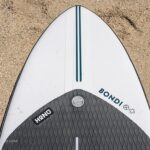Honu Bondi 8’8” iSUP Review
Pros
- Exceptional surf performance for an iSUP
- Extremely stable for such a short board
- Incredibly stiff
- Really good deckpad extending a long way forward
- Fantastic set of fins
- Really well thought-out design
Cons
- Since receiving these boards, the work output in the office seems to have diminished dramatically…
Australian brand Honu have spent the last 18 months developing their range of inflatable SUP surf boards – the hardest iSUP design challenge of all. Our team put the Bondi 8’8” and 9’5” through its paces in a variety of surf conditions.
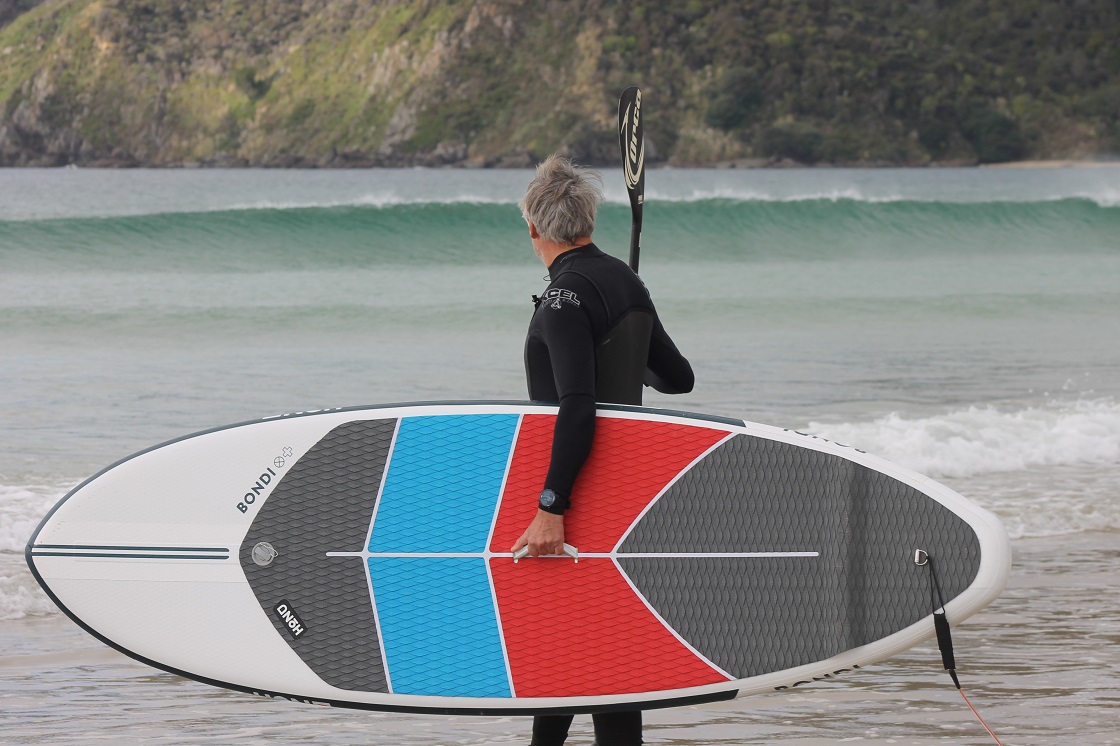
This review is mainly about the Honu Bondi 8’8”, as this is the board we have done the most testing on, and the model offering the highest performance. So we’re going to focus primarily on how the Bondi 8’8” works, and then summarise what the Honu Bondi 9’5” has to offer and how it differs, in its own section later on in the review.
Normally we like to get into the meat of a board review straight away, but these Honu Bondi reviews needs a bit of scene setting. (If you’re totally desperate to start learning how the Honu Bondi 8’8” actually performs, jump ahead to the Stability section, and you can return to this introduction later).
The Honu Bondi is an inflatable paddleboard designed specifically for surfing. And normally, that’s a big red flag right there. Many brands have attempted this before, but despite creating boards that can undeniably be used in surf, you’re always painfully aware that you’d be getting sooooo much better surfing on a hard board. Inflatable boards flex, bend, lose speed quickly, sit higher up off the water and don’t grip in turns. We’ve had a heap of fun surfing on inflatable boards when it has been the only available option, but the entire time you’re out there, particularly if you’re lucky enough to be on a half decent wave, you’re always wishing that you were actually on a hard board.
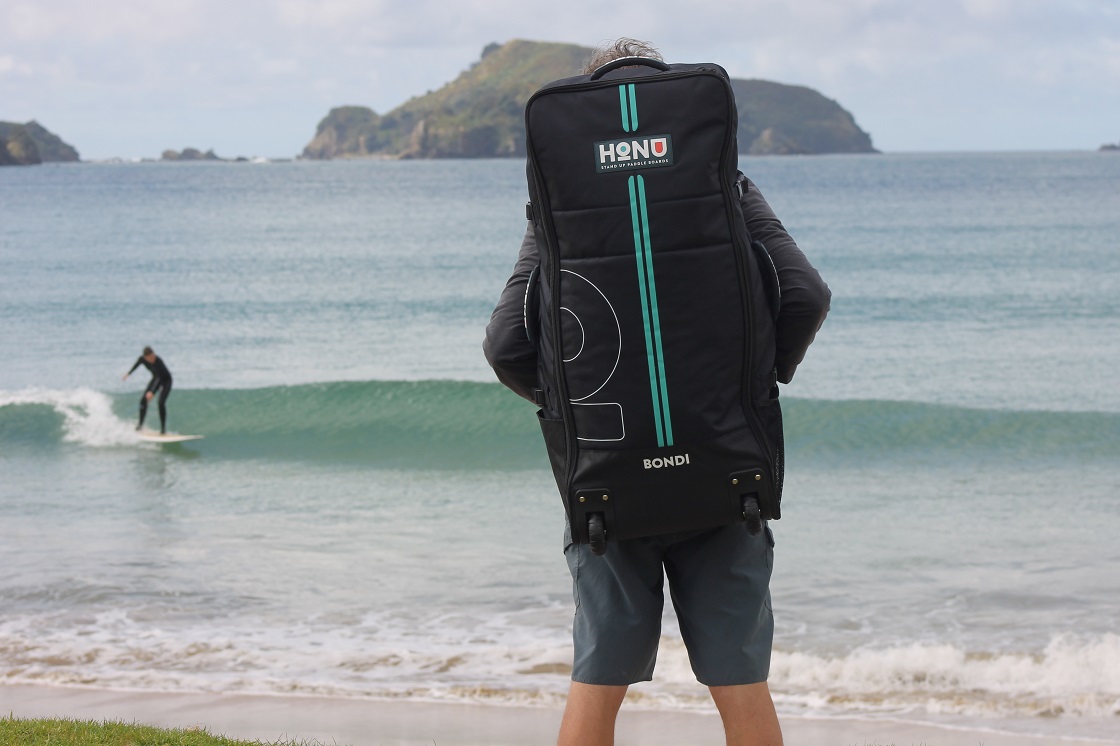
Nevertheless, it would undoubtedly be fabulous if really good inflatable SUP surf boards did exist. Traveling would be so much easier. Going to the coast? Chuck the iSUP in the truck, no need to have boards on the roof rack using up gas, or at risk of getting stolen. Flying overseas? Just one extra bag, no worries about getting your precious board smashed up by the baggage handlers.
However, the general consensus within the iSUP world has been that a) the essential problems are insoluble, and b) it’s an incredibly small market anyway because no self-respecting sup surfer really wants to be out on an inflatable – and the problems of traveling with a surf sup aren’t so great anyway, because they’re actually pretty small.
So in recent years there hasn’t really been much happening in this area of the market. Enter Honu, who after several years of development recently launched their Bondi surf SUP range, featuring the 9’5 and 8’8 sizes. We immediately started hearing positive reports, so we decided that we needed to check them out for ourselves (and of course, for you!).
For obvious reasons, this review will be somewhat different to our normal board reviews. When we’re reviewing an all round or touring iSUP, the concept is well proven and established. We don’t need to explain what stand up paddleboarding actually is, or how it works. Whereas with an inflatable SUP surf board, there isn’t that level of awareness.
If you’re reading this considering whether to buy a Honu Bondi, you probably fall into one of the following three categories:
- You’re currently already surfing on an inflatable sup, having fun but painfully aware that it’s not ‘the real thing’.
- You’re new to sup surfing in general, and are wondering whether an iSUP would be a good tool for getting into it.
- You’re an existing sup surfer who likes the idea of a traveling sup surf board, but is skeptical as to whether such a thing can actually be any good, in comparison to your existing hard board(s).
Whichever of those categories you fall into, you’re going to have a lot of questions before you make any investments in this area. So we’ll do our best to answer them throughout the review.
It’s also really important to appreciate that the scores given here cannot be cross referenced to our reviews on bigger boards. It’s comparing apples to oranges. The performance scores given here are essentially standalone, as there is literally nothing else to fairly judge this board against in this category. The numbers represent our view on how well the board performed against how we expected it to perform. In other words, how impressed were we by what we experienced?
So, enough introduction, let’s get started with our answer to the big question: can the Honu Bondi actually deliver decent surfing performance?
Honu Bondi 8’8″: Spec Sheet
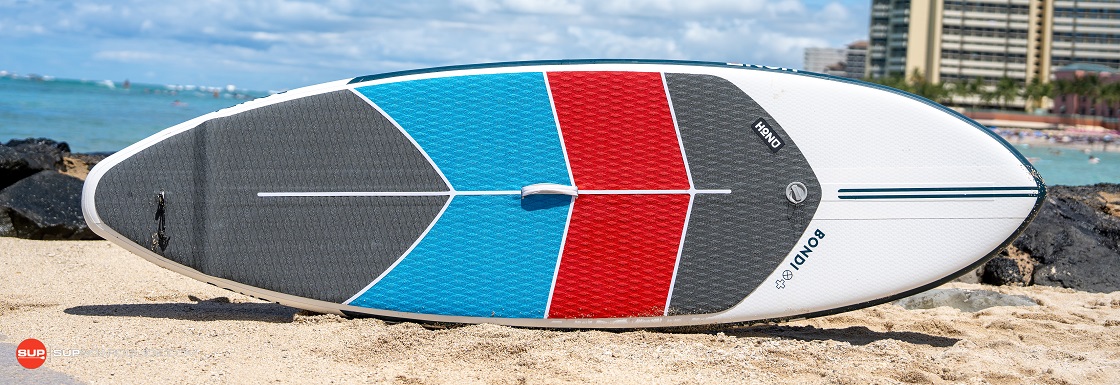
- Board Category: SUP Surfing
- Listed Board Dimensions: 8’8” x 32” x 4” , 9’5” x 32.25 x 4”
- Measured Board Dimensions: 8’8” x 32.25” x 4” , 9’5” x 32.75 x 4”
- Listed Board Weight: 8.4kg/18.5lbs, 8.8Kg/19.4lbs
- Actual Board Weights (inc fins): 9.2kg/20.25 lbs, 9.7kg/21.39 lbs
- Recommended PSI: 15-20 psi (recommended = 18psi)
- Fins: Volan 8″ Centre (US fin box) + 2 x side fins (futures fin box)
- Board Shell Construction Materials: double layer PVC + carbon rail reinforcement
- Drop-stitch type: X Woven
- Price Range: $890
- Warranty: 4 year total warranty: new for old replacement for any manufacturing defects.
Performance Review of the Honu Bondi 8’8″ Stand Up Paddle Board
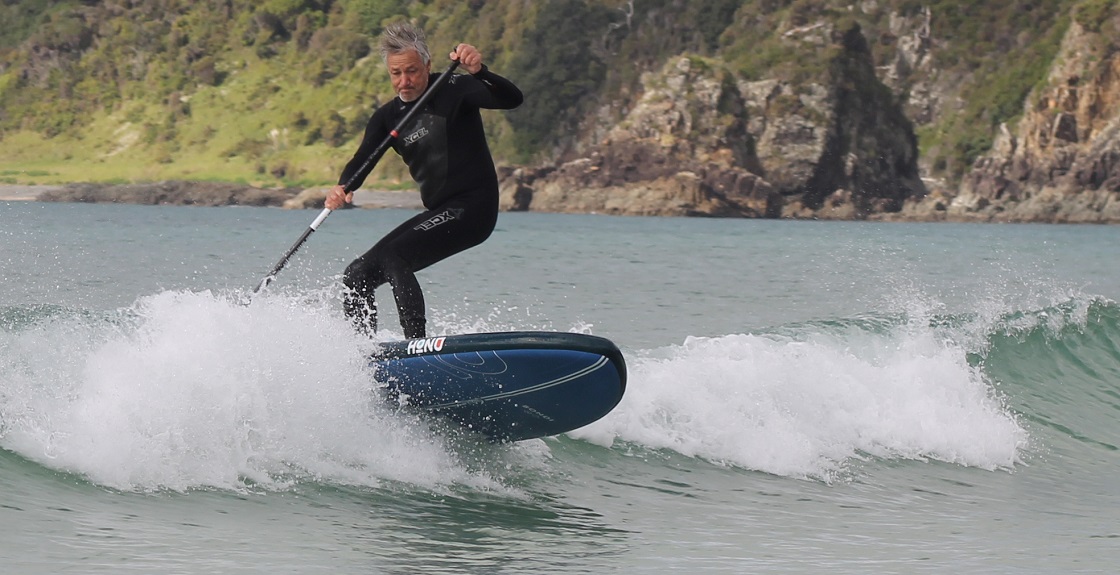
Overall Score: 9.8/10
- Stability: 9.5/10
- Speed: 8.5/10
- Tracking: 8.0/10
- Maneuverability: 9.5/10
- Construction Quality: 9.5/10
- Features/Accessories: 9.5/10
Note that these scores are for the Honu Bondi 8’8”. We will discuss the Bondi 9’5 in its own section later in this review.
Stability Rating: 9.5/10
The Honu Bondi 8’8” is extremely stable for a sub-9’ surfing board. It feels like there is a lot of board area under your feet. Honu states that the Bondi 8’8” is packing 168L, which is a lot of volume for a board of this length. An inflatable will always pack more volume into its plan shape than a hard board of the same size since it will be thicker throughout. But still, there’s no doubt that this board provides a whole lot of stability – more than you’ll usually find on a sub-9’ surf SUP. The width (actually slightly more than the 32” quoted), wide nose and relatively wide tail create a platform that a 180lb rider can stand on in complete comfort.
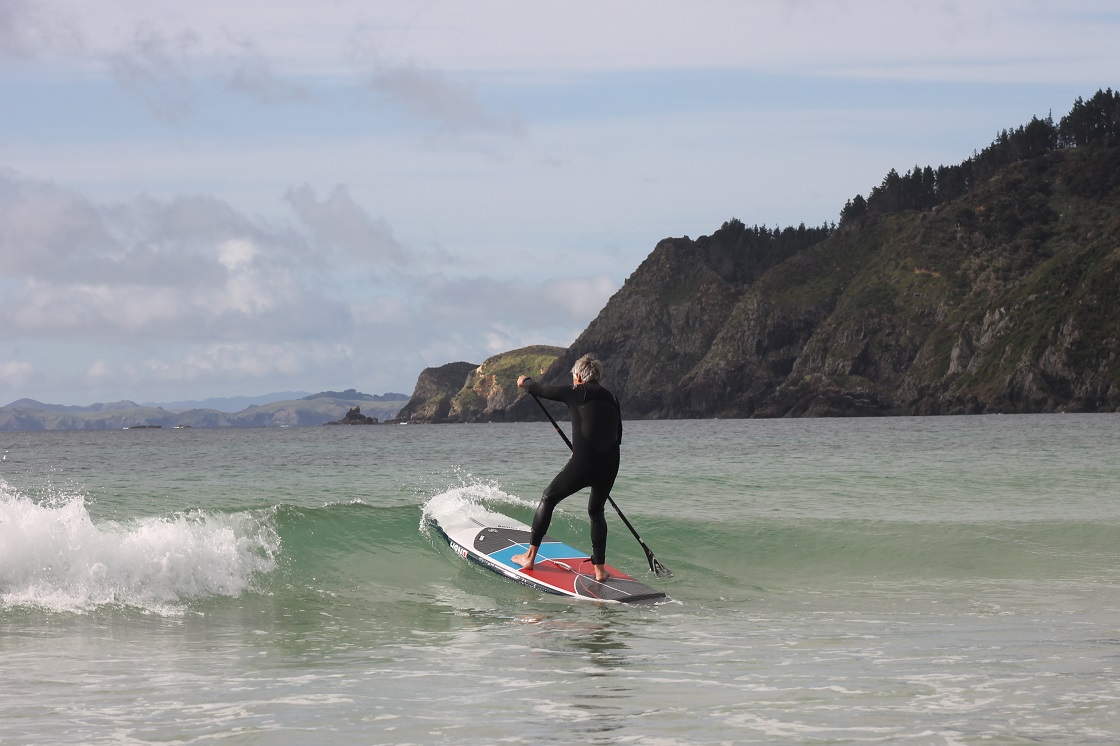
The iSUP rocker line, with its central flat section, is contributing a lot of stability too. Hard surfing boards tend to have a more continuous rocker line, whereas that’s almost possible to create on an iSUP. The Bondi 8’8” has rocker in the tail and nose but the center area is flat which creates a more stable platform underfoot.
And then there’s the fins. The Honu Bondi comes configured with three pretty large fins (more fin area than you’d usually utilize on a board of this size), which really hold the board steady. We used the board in both three-fin and twin-fin mode, and were surprised by how little difference it made to the stability when the center fin was removed, which really emphasized the fact that the stability of this board is primarily coming from the plan shape and rocker line.
Stability is an under-rated component of surf SUPs. All too many people get caught up in the ‘race to the bottom’, paddling out on ever smaller boards in the hope of cranking ever tighter and more radical turns. But the reality is, especially if there is any chop or wind on the water at all, tiny SUP surf boards are just a whole lot of work. The more stable you are, the easier it is to catch waves. The more waves you catch, the more fun you have. So we’re very much fans of stable SUP surfboards, and as soon as we got onto the Bondi 8’8” for the first time, we were super happy with what we found.
Stability Tip
If you’ve never been on a SUP surf board before, it will at first feel hideously unstable compared to something like a 11’ x 33” all rounder. But this is simply because you’re not used to the way a smaller board reacts. The board itself is still surprisingly stable and you’ll soon get used to it. But you should absolutely take some time to get to know the board on flat water before going anywhere near a wave.
If you are much heavier than 180 lbs and new to sup surfing you’d be better off with the Bondi 9’5, which has even more stability.
Speed Test: 8.5/10
Speed means very different things to a SUP surfer than it does to a racer. Indeed, you may not have considered that speed matters at all in surfing. But it does, and we’re happy to report that the Honu Bondi 8’8” performs pretty well in this respect too.
There are three main areas of sup surfing where speed is a primary consideration, and we’ll discuss each one separately below.
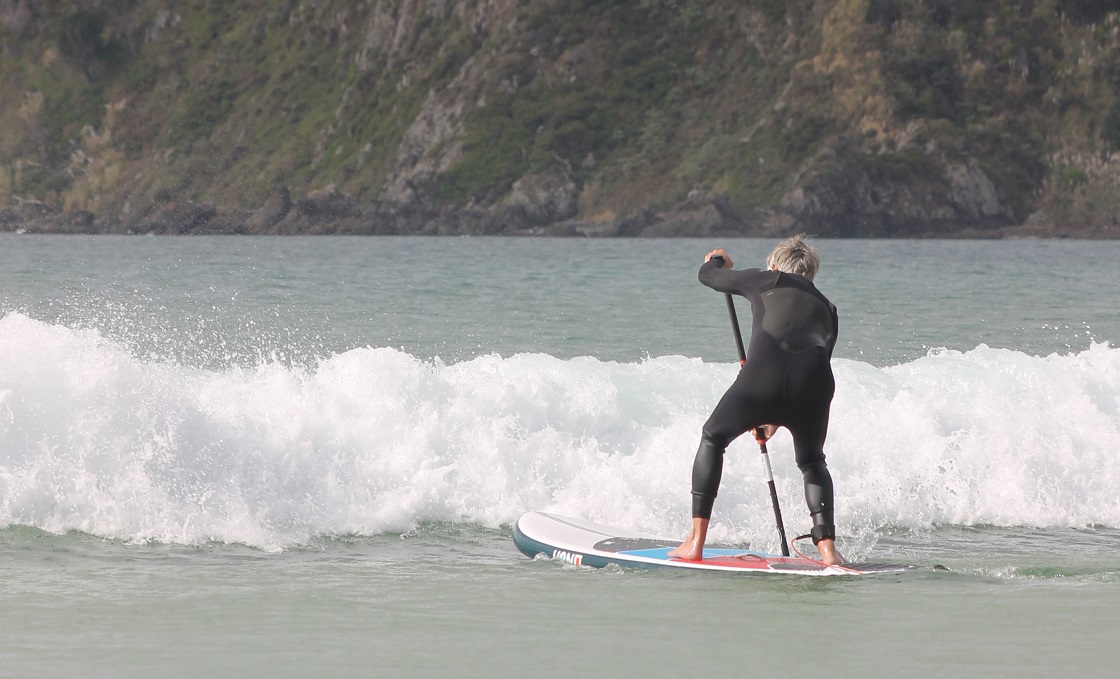
For starters, you need speed when you’re paddling out through the surf; particularly if you’re trying to get out through a gap between the sets or when you’re frantically scratching to get over a big one that’s about to break. In general, one doesn’t expect to get good speed from a short wide board, but actually, because the Honu Bondi 8’8” has surprisingly good tracking (as discussed in the next section), it works OK, and its straight line paddling speed isn’t bad at all, on a par with our hard boards of around 9’, and definitely faster than our sub-8’6” boards.
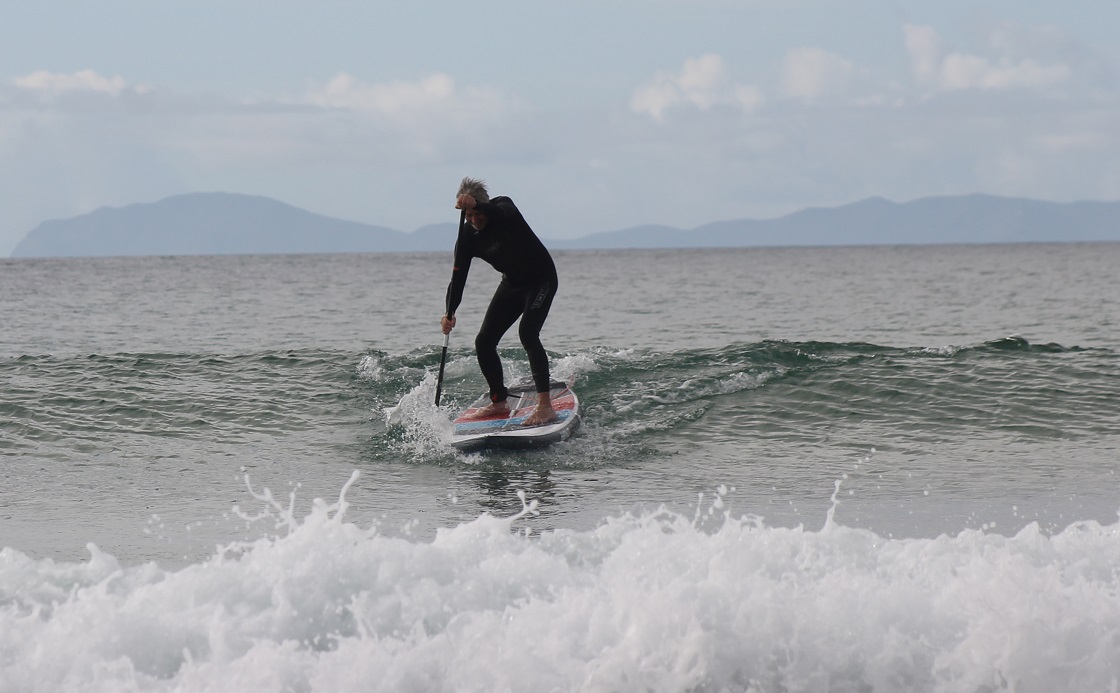
Next up, you need speed to catch the wave. More so if you’re trying to get onto the swell early or it’s a relatively shallow swell. All SUP surfers know only too well that frustration of giving it everything to catch a wave yet just not quite managing to get onto it! Again, this is traditionally where a short wide board can really struggle. There’s just too much width of board in the water which creates a lot of drag, and you haven’t got enough board length to generate power from.
However, once again, the Honu Bondi performs surprisingly well in this respect. (Genuinely surprising. Our reviewers honestly weren’t expecting it to be anything like as good as it was!). However to access that onto-the-wave speed, you do need to get a long way forward on the board – don’t be afraid to get your front foot right up to the front edge of the deck pad, well in front of the center carrying handle (and full marks to Honu for extending the deck pad right forward to allow this).
There’s enough width up there that the board is perfectly happy for you to be standing so far forward, and from here you can really propel yourself onto the wave when you need that extra burst of speed. Particularly if there’s any sort of offshore wind, in which case that wide nose is going to get hung up every time if you aren’t standing far enough forward. (Offshore winds is one area where having all that volume up front, the Bondi does suffer a bit in comparison to hard boards.)
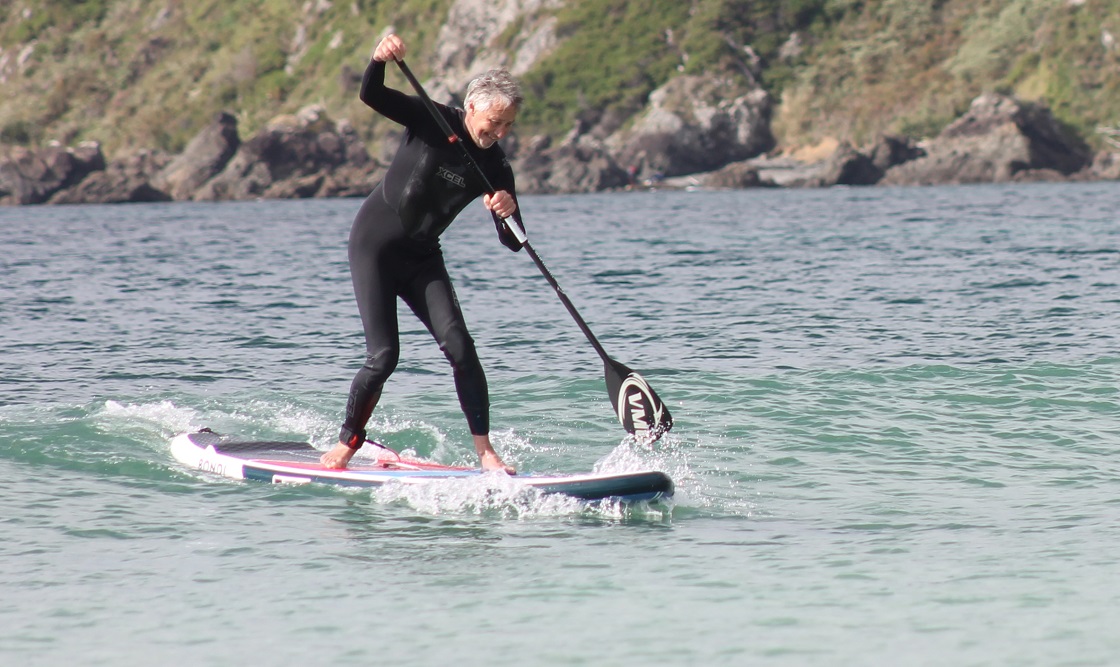
Top tip: You do need to paddle super hard – literally as energetically as you can – to catch a wave if it’s anything less than very steep. Use a sprint paddle technique – short rapid strokes up by the nose of the board. It should feel as though you’re trying to pull the board down the wave face, and as described, don’t be scared to get your front foot a very long way forward.
The other aspect where speed matters in a surf SUP is when you’re actually on the wave. Learning to create, hold and manage speed while riding a wave is a huge and complex subject, and something that takes years to master. And it’s really important, because more speed means better maneuvers.
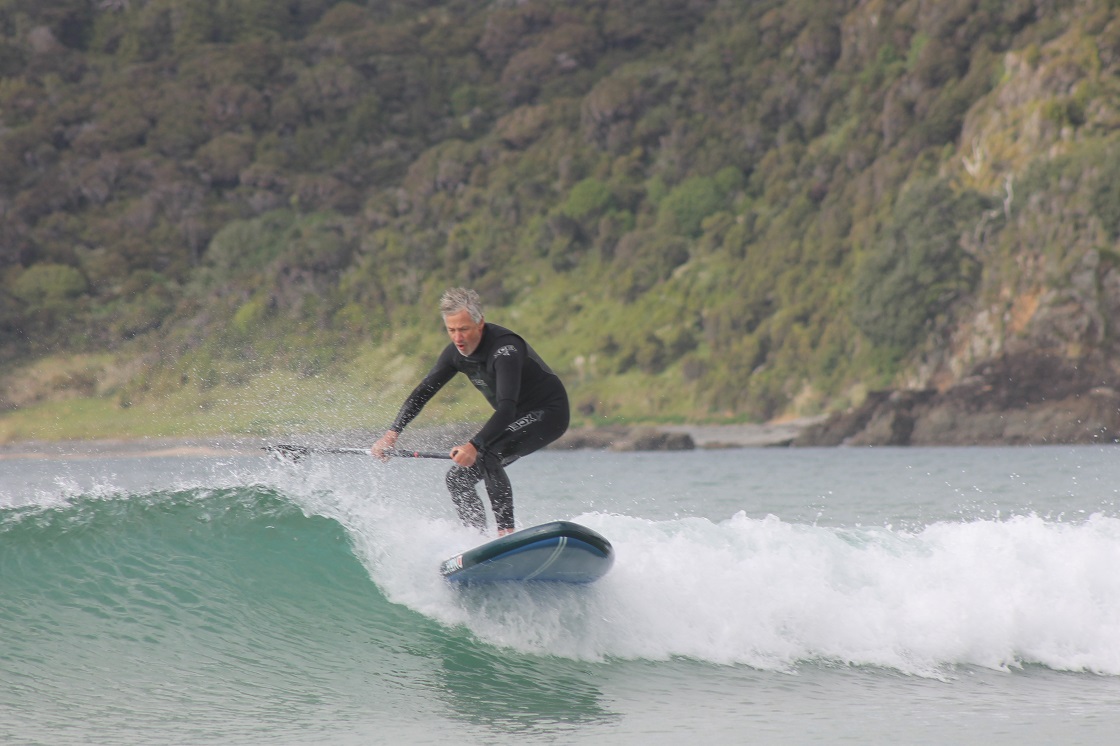
This is one area where inflatable SUP surf boards do suffer a natural disadvantage. Inflatables can hold up to solid boards pretty well on flat water. Even on a race course, the reasons inflatable raceboards may lose out to solid raceboards is more down to factors such as flex, and the more sophisticated bottom shapes that hard boards can be built with, rather than any intrinsic issues with the actual material that the board is constructed from.
However, on a fast raceboard, even paddling as fast as you can you’ll be doing well to crack 6 mph. Whereas when surfing a wave we’re talking a whole different realm of speeds. Even on a relatively slow wind swell, you can easily be doing 12 mph or more. Twice as fast as a raceboard. And at these speeds, dimpled PVC tends to grip the water tighter than a smooth epoxy hull does. So the reality is that inflatable SUP surfboards just naturally aren’t as quick on the wave.
The situation isn’t helped by the 32” width of the Honu Bondi 8’8”, which is pretty much as wide as sub 9’ surf SUPs come. Width directly equates to drag. However, on the other side of the coin, the Bondi’s impressive stiffness definitely works in its favor. Flex saps the speed out of your turns quicker than anything on the wave, and this is normally where inflatable SUPs just suck – literally. Not so with the Bondi; you really don’t notice any significant flex when you’re driving the board through the turn.
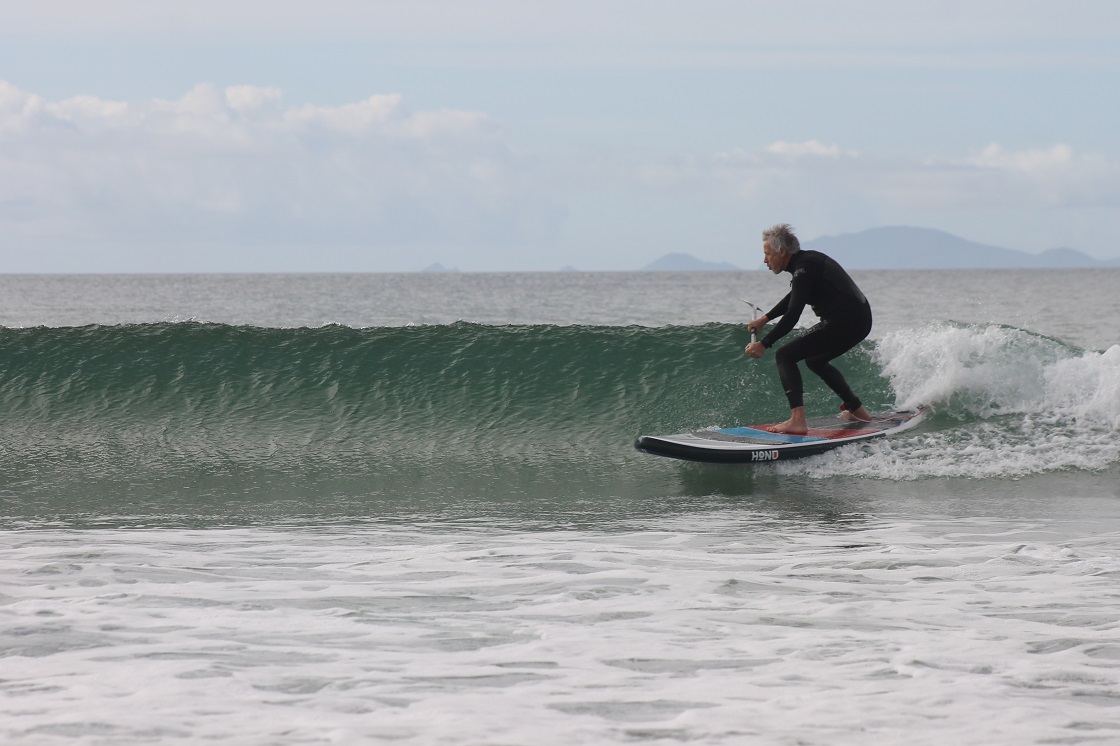
Nonetheless, you do notice that it’s slower than you’d expect to be surfing a hard board. For the experienced surfer, this simply means some adjustment in technique. On any reasonably steep wave there’s usually speed to spare, so you just need to adjust where you are on the wave face, the lines that you draw and your front foot pressure to generate more speed when needed – and be aware that when you’re coming back up the wave the speed bleeds off a little quicker. Likewise, don’t expect to be able to hold a high line at speed on a fast wave, because you’re relying on the fins for grip and the board is so wide up front.
For the less experienced surfer, this lack of speed will probably mean that you will find smaller, slacker surf conditions more of a challenge, because you’ll be struggling to find any speed and will quite probably be stalling in your turns. This isn’t the place for long how-to sections on getting the board moving faster; the main thing is just to be aware that the Honu isn’t a natural rocket-ship on the wave. If you really work on your speed management when you’re surfing, you should soon figure it out. Focus on learning how to get and keep your speed up first, before starting to try and crank those harder turns.
All the speed analysis thus far is based on the board configured with all three fins. So how does it differ in twin fin mode? Well, the board is unquestionably faster. Full disclosure; having used both modes extensively we are now using the Honu Bondi 8’8” almost exclusively in twin fin mode. However, there’s no doubt that removing the center fin also affects the tracking and the way the board turns and rides waves quite a bit, particularly for the inexperienced SUP surfer. We’d definitely recommend starting out with all three fins, and then experiment. It’s a really nice aspect of the Honu Bondi package that it can be used in these different configurations.
To obtain our speed test results, we use a Speed Coach SUP 2 device from NK Sports. This gives us accurate real-time readings on how fast we are paddling and our stroke rates. For the top sprint speed, we paddle as hard as we can for approximately 10-15 seconds and then record our average speed. For the casual test, we paddle at 35-40 strokes per minute for approximately 30-60 seconds and record the average speed.
Tracking: 8.0/10
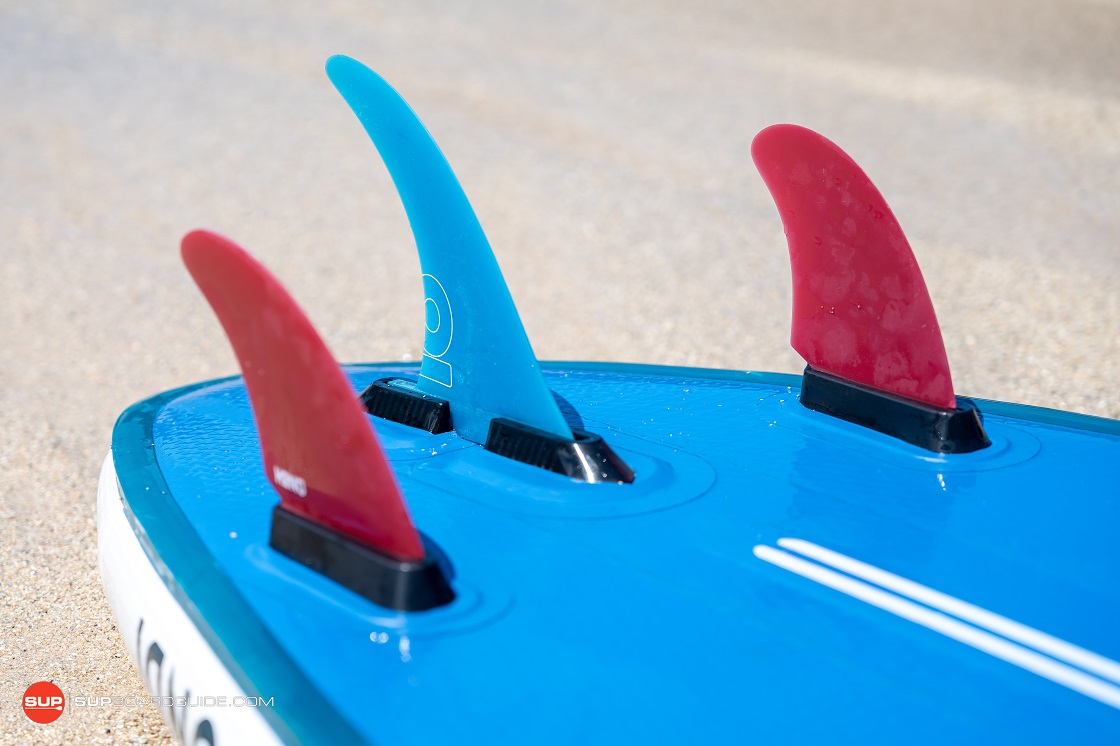
Tracking is another parameter that doesn’t usually feature at the top of the list when choosing a surfing board. The whole point of a surfing board is that it doesn’t hold a straight line, right? Turning is what it’s all about.
However, once again, in the surf SUP environment, it does actually matter. On any board much shorter than 10’, each paddle stroke becomes more and more about turning. The shorter and wider the board, the more inclined it is to turn. And if you’re turning you’re not going forward (or you’re expending more effort counteracting the turn).
This becomes a hugely important issue when you’re paddling for a wave. You absolutely need to be able to hold your course while doing this. If you need to change sides with your paddle while you’re trying to catch a wave, you won’t catch the wave – period.
It’s also important when you’re trying to paddle out over the white water, when you’ve essentially only got 8-12 seconds between waves (maybe even less) in which to re-establish some forward momentum and get yourself pointing in the right direction.
This is why, for anyone wanting to get good at SUP surfing, learning to put some draw into your stroke so that you can hold course while paddling on just one side, is hugely important. (Another thing to learn on flat water).
However, no matter how good your draw is, if your board is too pivotal, it just makes life a whole lot harder. And this becomes a really big factor when you get onto boards much shorter than 9’. Their straight line tracking is generally abysmal.
However, again the Honu Bondi 8’8” scored surprisingly well in this department, especially considering its extreme width. This one is a little easier to decode though, it’s primarily because there is so much fin area under the tail. Those three large fins really help lock the board onto its course.
To our surprise, putting the board into twin fin mode didn’t actually affect the tracking that much. For sure it was less, but still surprisingly good for an 8’8” board. It took a full reconfiguration into thruster mode, using three smaller identical-sized fins, to bring the tracking down to what we’d usually expect from a board of this size. But if you’re choosing to use smaller fins you clearly know what you’re doing, and you probably have the full repertoire of tricks to help you hold your straight line anyway. Whereas for the less experienced SUP surfer, this above-average tracking performance, as with the stability and speed, is gold.
Maneuverability: 9.5/10
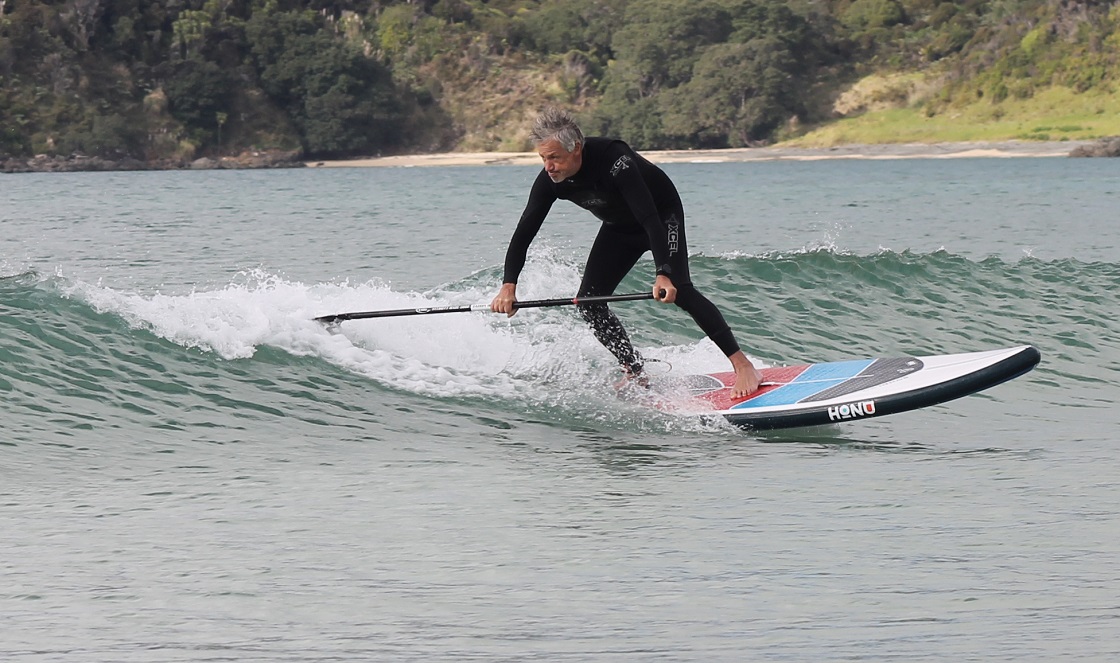
Ok, so it has taken a bit of time to reach what many might consider the only thing that really matters in a SUP surfboard. However, there is much more to a SUP surfing session than simply riding the wave, as any experienced SUP surfer knows. Unlike prone surfers, for whom the ride is everything, how our board gets us out to the wave and on to the wave is in many ways just as important as the ride itself. Because if you’re struggling to get out, to hold position in the line-up and/or to catch the right wave when it comes, you ain’t going to be doing much riding! So it’s really important to consider the whole package when discussing how a SUP surf board performs.
But now that we’ve discussed those other attributes, we can turn our attention to how the Honu Bondi 8’8” actually rides. And for sure, it is the most important performance consideration, because if the board can’t deliver in this department then the other stuff doesn’t matter anyway!
First thing to understand is that, because the rails are so thick throughout – as with any inflatable board – there is only one way to ride the Bondi 8’8”, and that’s with your back foot right back on the kicker. You have to turn this board from the tail. If you try to turn while standing amidships you’ll just catch the rail.
You also aren’t able to transition from rail to rail in the same way as you can the majority of hard surfboards, because there’s absolutely no vee to assist in this. The bottom of the Honu Bondi is completely flat – end of story.
So essentially you’re pivoting rather than laying the board in along the rail like you can a hard board – your turns are quick and snappy rather than drawn out. If you’re an experienced surfer who loves cranking super high speed bottom turns, you’re going to have several interesting wipeouts until you’ve adjusted your technique when you first get onto this board!
As discussed previously, the Honu Bondi doesn’t really hit the top speeds in the same way anyway. So it quickly becomes natural to turn it from the tail, flatter and with more weight on the back foot. And driven like this, the board actually turns really well. Again, we were genuinely surprised. We rode waves where we forgot we were even on an inflatable. And that’s about as high a compliment as you can pay, really.
This is where the relatively short length of the Honu Bondi really comes into its own. While it definitely feels more like a 9 ‘0 board or longer when you’re just cruising around on it, when you get onto the wave, the simple fact is that you’re on an 8’8” board, which is easy to throw around. It comes round quickly and pops up nicely over the white water for floaters.
Again, congratulations to Honu for thinking outside the box in many ways with the Honu Bondi package. They’ve really given some serious thought to the issue of how to make an inflatable surf sup grip actually in the turn on the wave – which is where the disconnect between iSUPs and hard boards is most noticeable. They’ve addressed it in three different ways.
- Firstly, the hard edge in the tail area helps a bit. It gives a slightly cleaner bite and track to the turn.
- Secondly, the well pronounced kick pad is really easy to find and anchor your foot on, so you’re turning from the right place. (More on that anon).
- Thirdly, the side fins are high quality, stiff and above all, big. Much bigger than you’d normally put on a board this size. But because you’re relying on the fins so much when you’re turning this board, it makes total sense. You soon learn that you can actually trust them, they will grip and hold you in, when normally on an iSUP you’d have lost traction long ago.
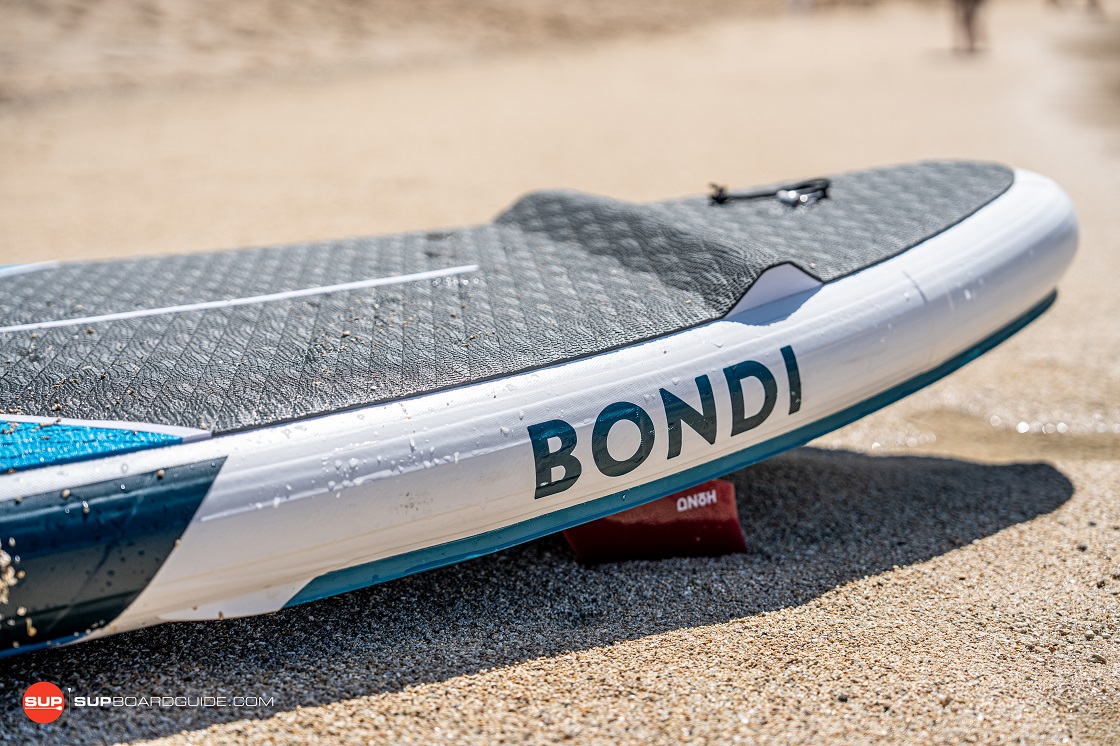
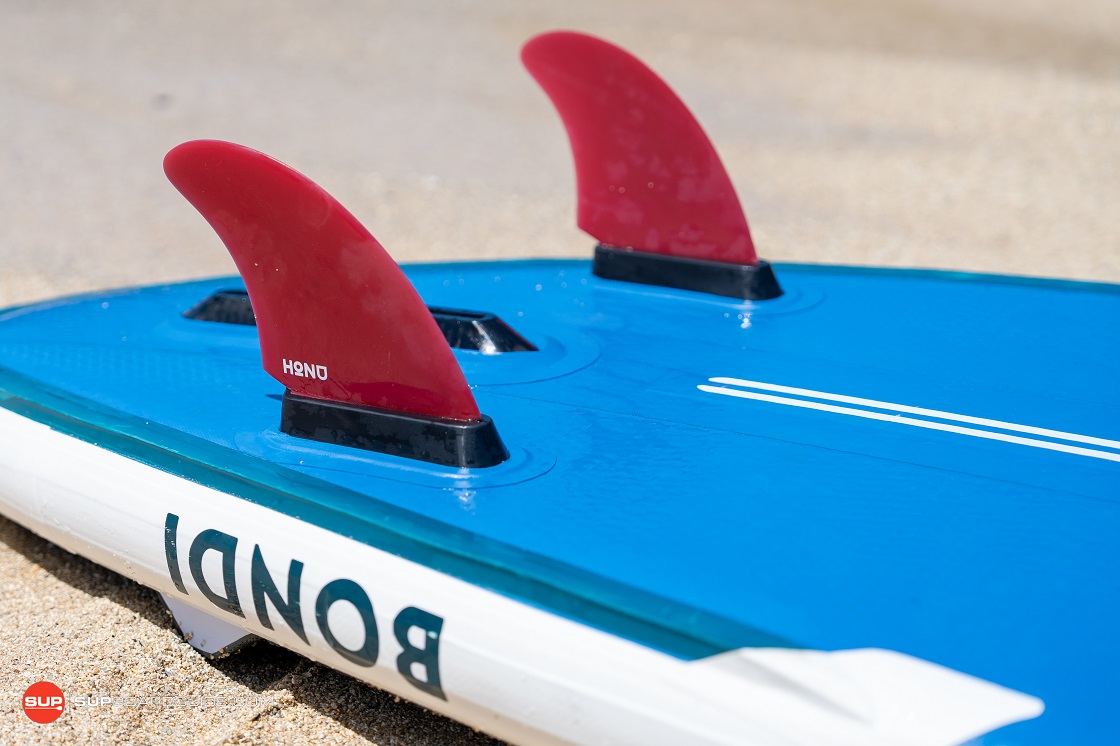
The only part of the wave ride where being on an inflatable feels a bit scary is during steep re-entries; coming off the top when the wave breaks or after a floater, are a little hairy as the board has all that volume up in the nose, and this again is where you feel that slight catch from the PVC when the board re-engages at the bottom of the wave at high speed. Really using your paddle as much as possible to crank the top turn helps keep the nose up, but the re-entry is still an area where you feel a bit vulnerable. This is the one area where we think there is potential to adjust the design and raise this board’s game even further, as we’ll discuss later.
Overall though, the board’s maneuverability is astonishingly good; in a completely different league to any other iSUP we’ve ever surfed. Once you’ve got used to turning slightly flatter and much more off the tail, you’ll have a whole lot of fun throwing this board around in the waves.
As mentioned earlier, we’re now almost always using the board in the twin fin configuration, which we’ve really come to like. It gives the board a more loose, skatey feel. However, whereas classic twin fin (solid) surfboards are more about high speed wide carving turns, you still need to turn the Honu 8’8” off the tail rather than engaging the rail, so it’s not like a true twin fin in that respect, but it definitely feels looser (and faster) than the three fin mode.
What we haven’t had the chance to really explore yet is using the board thruster mode (3 identical size fins), which should in theory allow for even tighter turns, breaking out the tail in the top turn and the like. We’ll be exploring this the next big session we get.
But the very fact that we’re even able to think about reconfiguring an iSUP to change its surfing characteristics is a huge statement in itself. It’s not something that’s even been on our radar before with an inflatable board. We’d love to see someone like Kai Lenny put a board like this through its paces in some consequential surf, it would be an absolute blast to see just what an iSUP can actually do.
Construction Quality: 8.5/10
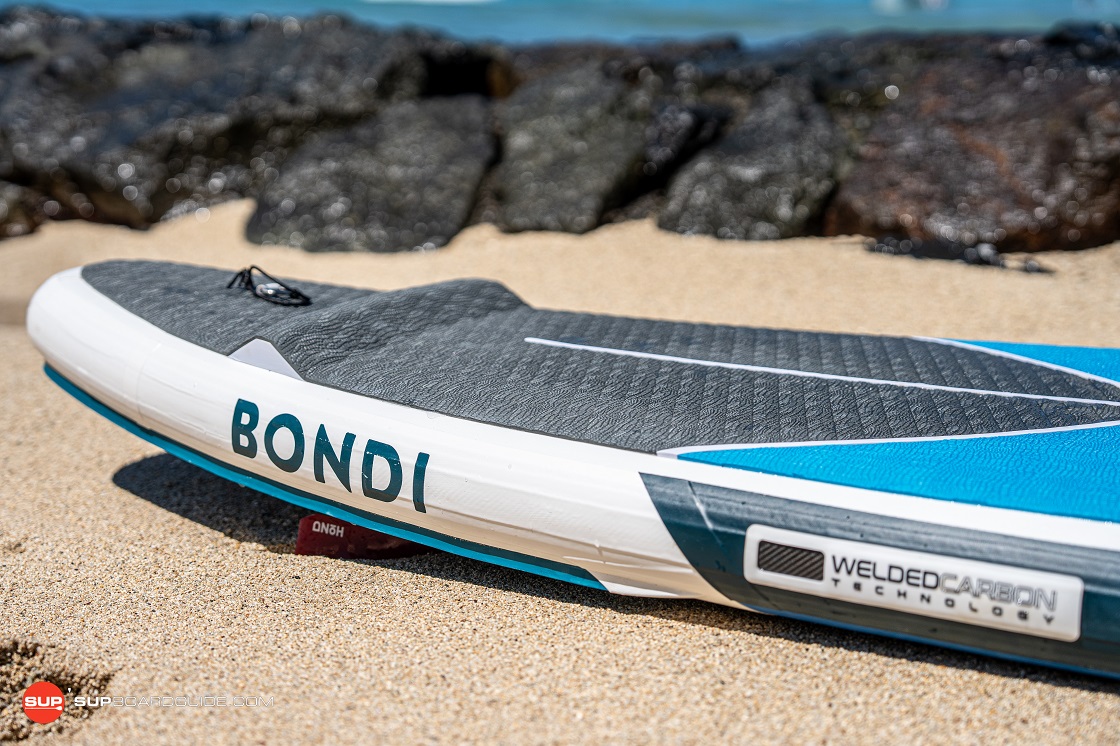
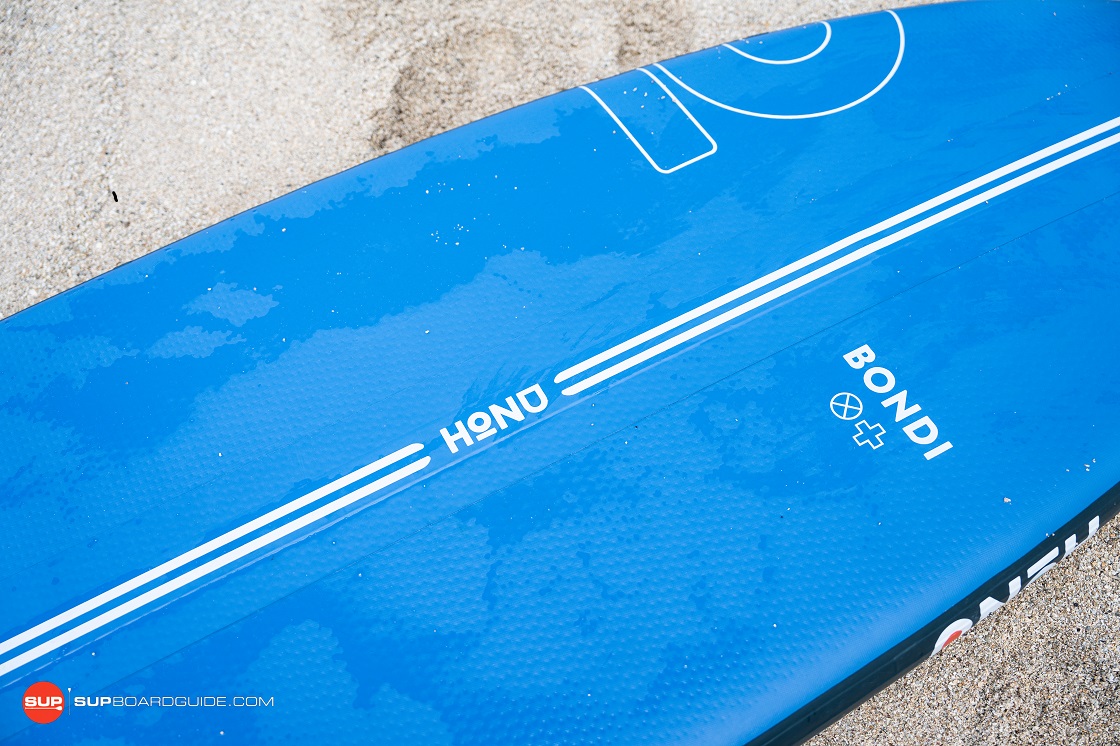
Honu have been on our radar for some time due to their extremely high quality construction, their boards are undoubtedly amongst the stiffest of all inflatable paddleboards on the market. So this was one of the main reasons we were prepared to take seriously their claims that they had managed to produce a quality iSUP surfboard in the Honu Bondi.
As mentioned earlier, the success or failure of any iSUP surfboard project comes down to the construction. If the board isn’t rigid enough, then no matter how good its shape or features, its flexiness becomes the dominant feature when you try to surf it.
The challenge is that much greater when the board is just 4” thick. Most inflatables are 6” thick, simply because this is the easiest and most potent way to make a board stiff. The thicker it is, the stiffer it is. Nobody makes 4” thick all round or touring iSUPs now, simply because they’re too flexy. So could Honu pull it off with the Bondi?
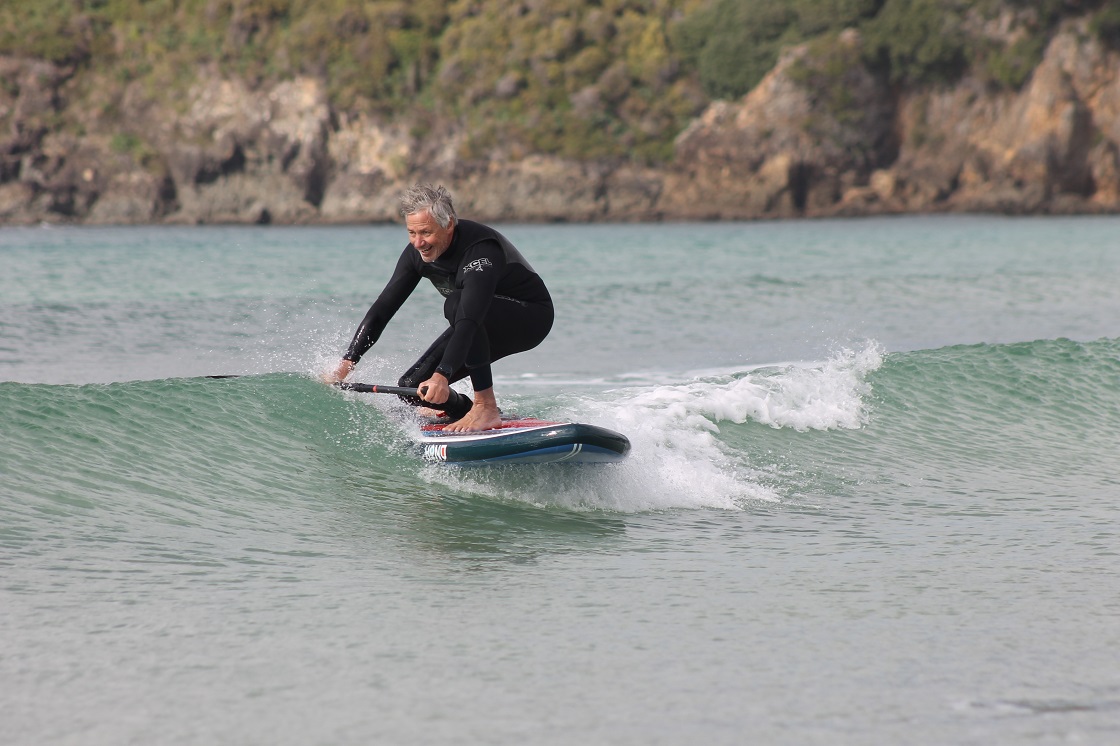
It does of course help that the board is short and wide; both of which help with the innate stiffness of an iSUP. However, Honu’s excellent construction also plays a major part. This board is in fact extraordinarily stiff and rigid in feel. So how have they done that?
The X woven dropstitch, while expensive and more difficult to work with, is definitely a big factor. The outer skin features two layers of PVC fused together, with additional longitudinal 50mm TPU-coated carbon stringers on the deck and underside which also add stiffness.
The rails construction plays a huge part in achieving such a stiff board. Heat and pressure welding is used to fuse the inner rail to a carbon rail strip, with an outer layer then applied for extra reinforcement and rigidity. Essentially it’s a 3 layer rail, and it feels extremely solid.
Overall, this board is an impressive example of inflatable construction, and it’s worth also mentioning Honu’s excellent 4 year warranty, which promises to replace the board if there are any manufacturing issues including seam failure or traction pad delamination. Honu is clearly very confident in this construction process.
Board Stiffness:
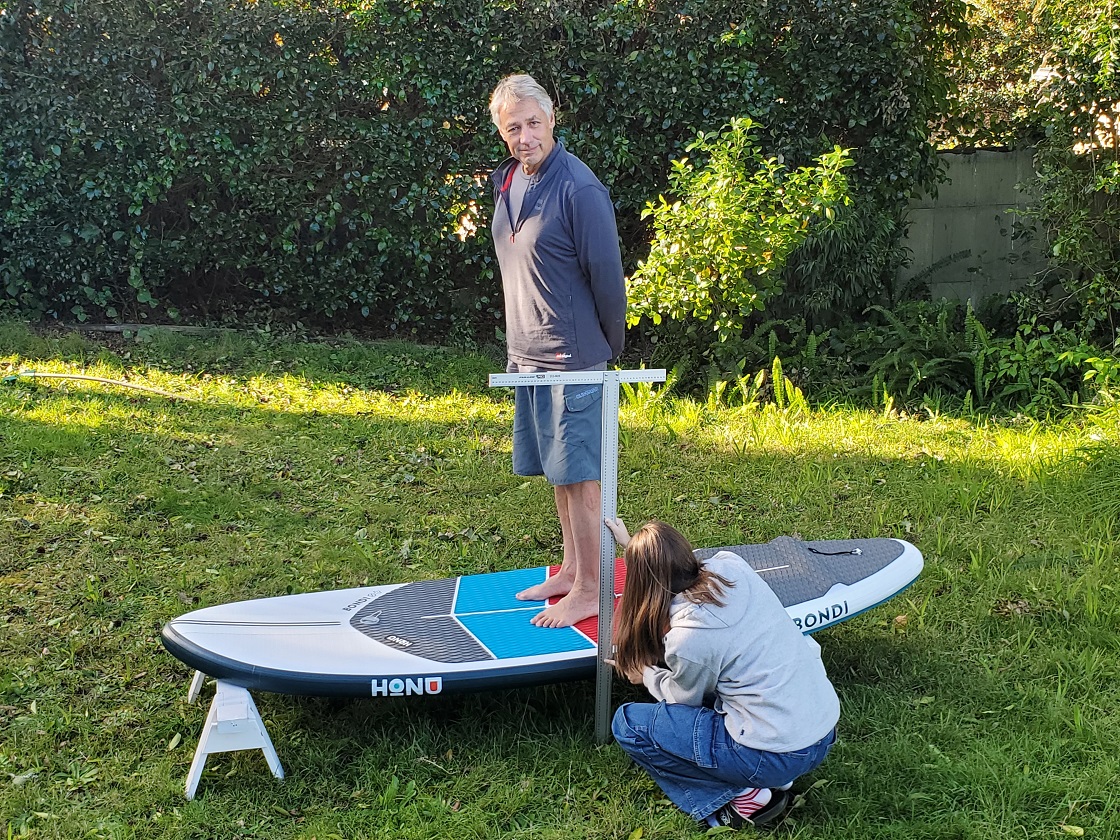
We have a standard laboratory process for testing the stiffness of boards, described in detail in our other reviews. However, it wasn’t designed with boards shorter than 9’ in mind! So to get an idea as to the stiffness of the Honu Bondi 8’8” we did a rather more straightforward test, as can be seen in the picture above. The rear sawhorse was placed just in front of the finboxes, and the front sawhorse set 1’ in from the nose. Under a load of 170 lbs, the deflection was a miniscule 0.67”.
But more importantly, when you’re standing on the board like this, it simply doesn’t feel flexy. There is no obvious give at all when you put your weight onto it.
To ascertain the rigidity of each board we review, we use our own specific laboratory bend test process. The board is inflated to its maximum recommended PSI and then placed across two sawhorses positioned exactly 7 feet apart. We then measure the distance from the middle of the board to the floor. Then, we place a 150 lb weight on the middle top of the SUP, and measure the distance to the floor again. The difference between the two measurements shows the deflection, or ‘sag’, that the board has experienced due to the added weight. We have been reviewing the stiffness of boards using this technique since 2021 and while it isn’t an exact replication of the weight distortion that occurs when a rider stands on a SUP board in the water, it still gives a very useful comparative tool in determining the stiffness of the board’s construction process.
The Honu Bondi 9’5”
So now that we’ve explained how the 8’8” performs, let’s talk about the 9’5”.
Essentially, it’s pretty much the same board but 9” longer, which is actually quite significant when we’re talking about surfing boards. So what does this mean in terms of how it performs?
Stability
The Bondi 9’5” offers even more stability than the 8’8”, which will increase the appeal of the board for newcomers to SUP surfing, and heavier riders. However, because width is by far the most important parameter when it comes to weight-carrying and the 9’5 is only half an inch wider, the extra weight carrying ability of the board is not going to be massive.
Honu (wisely) does not offer any suggestions for maximum rider weights, and we have not had the chance to put heavyweight testers onto either of the boards yet. So our instinct is that the 9’5 will probably be good for up to around 200 lbs for inexperienced SUP surfers.
For heavier competent SUP surfers, the board should be fine in terms of stability, but they may experience more flex and distortion in the board. It is after all only 4” thick, and it’s doing an extraordinary job already in delivering good surfing performance for 180 lb riders! There may well be an upper weight limit in terms of what 4” construction can cope with. We need to do more research in this area, and will update our findings when we can.
Speed
The extra length of the 9’5 translates into a small but noticeable speed gain when paddling out, and paddling onto the wave. However, once you’re on the wave, you definitely notice that the board is a bit slower to accelerate out of turns and in terms of down the line speed. The extra length means that you need your front foot that bit further forward in order to get ‘onto the accelerator pedal’. 9” more length might not seem like a lot but it does mean a wider stance, which won’t feel natural to everyone. (Or conversely, it makes it harder to get your back foot right back onto the kicker, where it absolutely needs to be).
There is also a bit more board to get held up by offshore winds when you’re paddling onto the wave, so you really need to get your weight forward even more, but then move very quickly to get back so that you don’t bury the nose.
Tracking
As you would expect, the extra length of the Bondi 9’5 means that it tracks a bit better than the 8’8, which is noticeable when you’re paddling out, or scratching hard for a wave.
Maneuverability
The extra length of the Honu Bondi 9’5 inevitably takes its toll in this department. It doesn’t turn so tightly, nor is it so easy to project over sections. There is more swing weight in the nose. It’s just as important, if not more so, to drive the board from the tail, which inexperienced SUP surfers may find harder as it’s that bit further away from your natural standing position.
But all in all, it still performs pretty well, and as a learning board it’s excellent. For heavier riders the extra length will still slightly reduce the turning performance, there isn’t really any getting around that. Maybe in future, if these boards prove as popular as they deserve to be, Honu can bring out a Bondi 9’0, which will be the perfect heavyweight performance board.
Should You Buy the 8’8 or the 9’5 Bondi?
We elected to have Honu send the 8’8 version to me, and the 9’5 version to Justin. At some point we’ll be able to get together and have both of us test these boards side by side. Until then, I think our recommendations align with the reason why we sent the longer version to Justin and the shorter to me.
Justin is less experienced in SUP surfing and so one of his biggest concerns was stability, whereas I am very comfortable surfing with a SUP and wanted something that was highly maneuverable and would perform great in all conditions. I didn’t need the larger board for that.
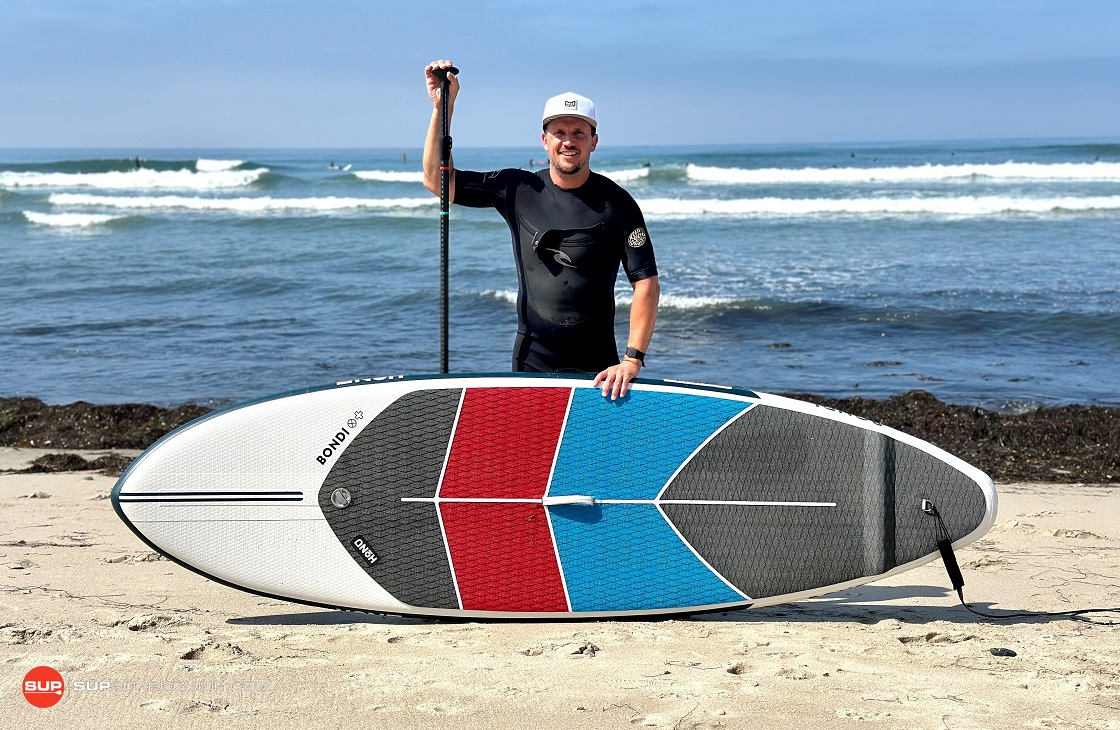
Bottom line: if you are a beginner and need stability or a larger paddler, go with the longer board. It will still be a lot of fun. Justin really enjoyed the 9’5 at both Waikiki and Old Mans in San Diego, and the extra stability provides a great platform to develop his SUP surfing skills while making it very easy to catch even very small waves.
Features/Accessory Review: 9.5/10

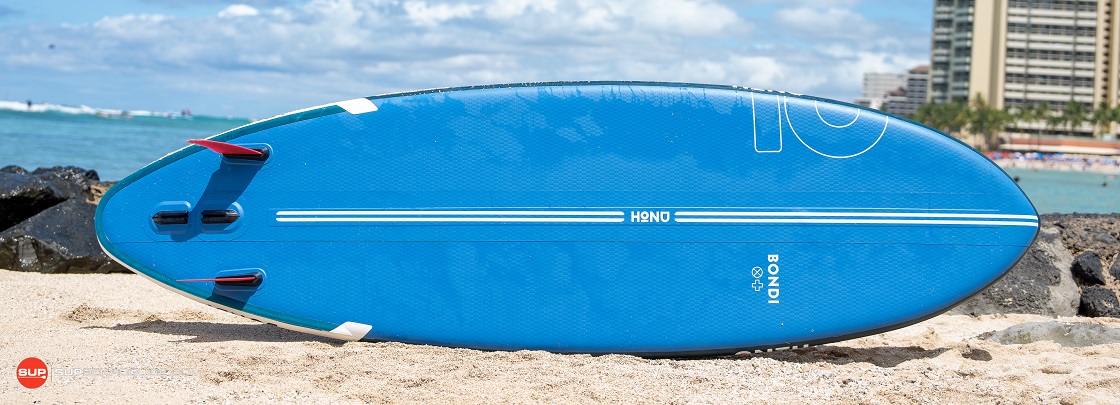
Features:
Again, a very high score for features and accessories. Not because there are lots, in fact quite the opposite. But everything that’s there is excellent. A lot of thought and attention to detail has clearly gone into exactly how to make this board work.
The traction pad on the Honu Bondi extends a long way forward as shown above, great for getting your weight up front to power yourself onto the wave. The pad features a diamond texture, which gives excellent and comfortable grip for bare feet. A small but significant detail; the orientation of the diamonds changes from longitudinal to lateral on the rear pad, as that is the way your foot will be aligned. The kick pad is actually more of a ridge, running right across the board.
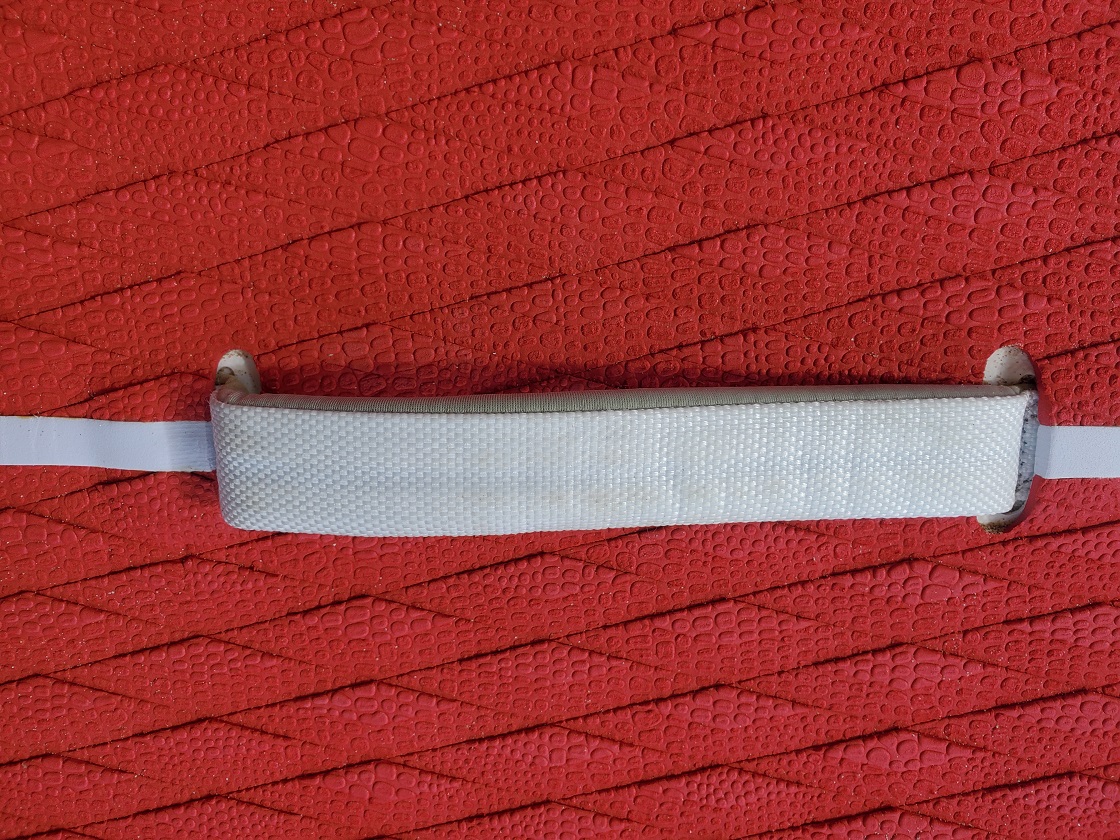
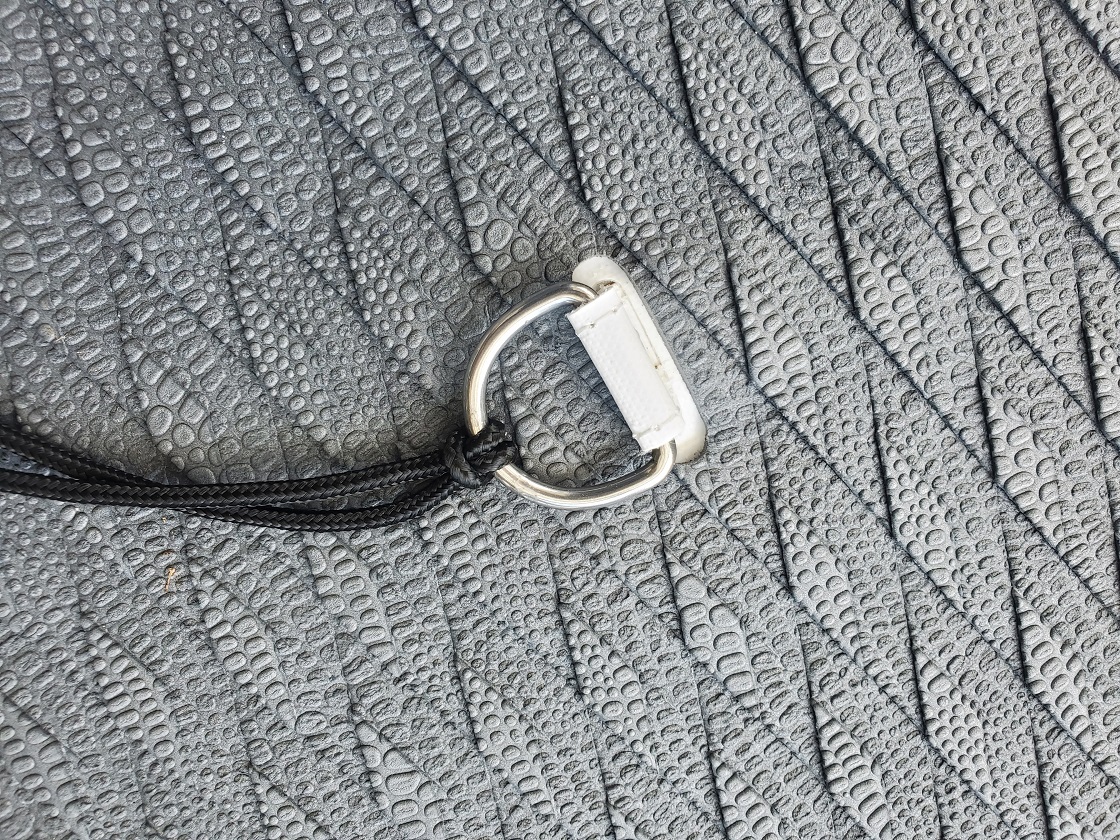
The center handle is light and simple, which is absolutely fine as the board is extremely light so it’s not difficult to carry. The leash fixing is a steel D Ring well fixed to the rear deck underneath the traction pad, which gives good confidence that it’s not going to easily get ripped off. .
Unlike your typical recreational board, the Honu Bondi is pure surf in terms of extra fittings, i.e. there are none. No bungees, cargo fixings, or action camera mounts. (The last one, we totally understand the logic of, as it will add weight where it’s not wanted. However, it would have been a whole lot of fun to have one, to record some of the great waves we were scoring!)
One unusual quirk of the board is the location of the inflation valve; halfway between the center handle and the nose. The reason for this is that the tail area is pretty congested already, while putting it on the nose adds weight in an area you really don’t want it. So Honu has gone for the middling position. It makes it very slightly harder to squeeze all the air out of the board when you’re rolling it up (a pump with a deflate function is a great asset in this situation), but it’s not impossible.
Normally, when we take our focus to what’s happening on the underside of an iSUP, there’s not a whole lot to say. But with the Honu Bondi, this is actually where a bunch of the most important stuff is going on. For starters, there’s the hard rail edge in the tail, which improves the speed and acceleration and gives a more positive feel to the turn. The bottom central stringer is clearly visible too, contributing to the overall stiffness of the board.
Then there’s the finboxes. Honu have developed a ‘futures’ compatible glue-on fin box system specifically for the side fins. (Futures fin boxes are a clip-in fin mounting system with a single allen key screw to lock the fin in place, increasingly popular in surfboard manufacture, as they are widely reckoned to be stronger than the more traditional FCS fin boxes.) The center fin mounts in a US box, adapted so that the board is easier to roll up. The side finboxes are set to create a slight toe-in, and a subtle outward cant.
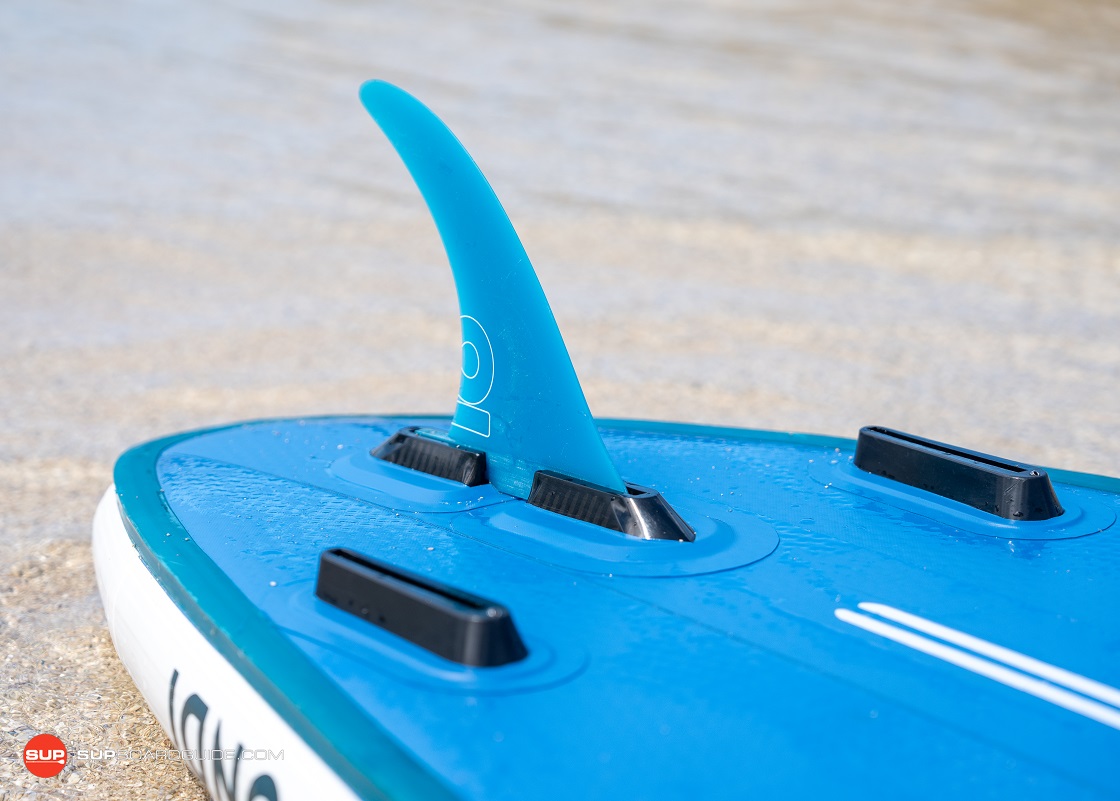
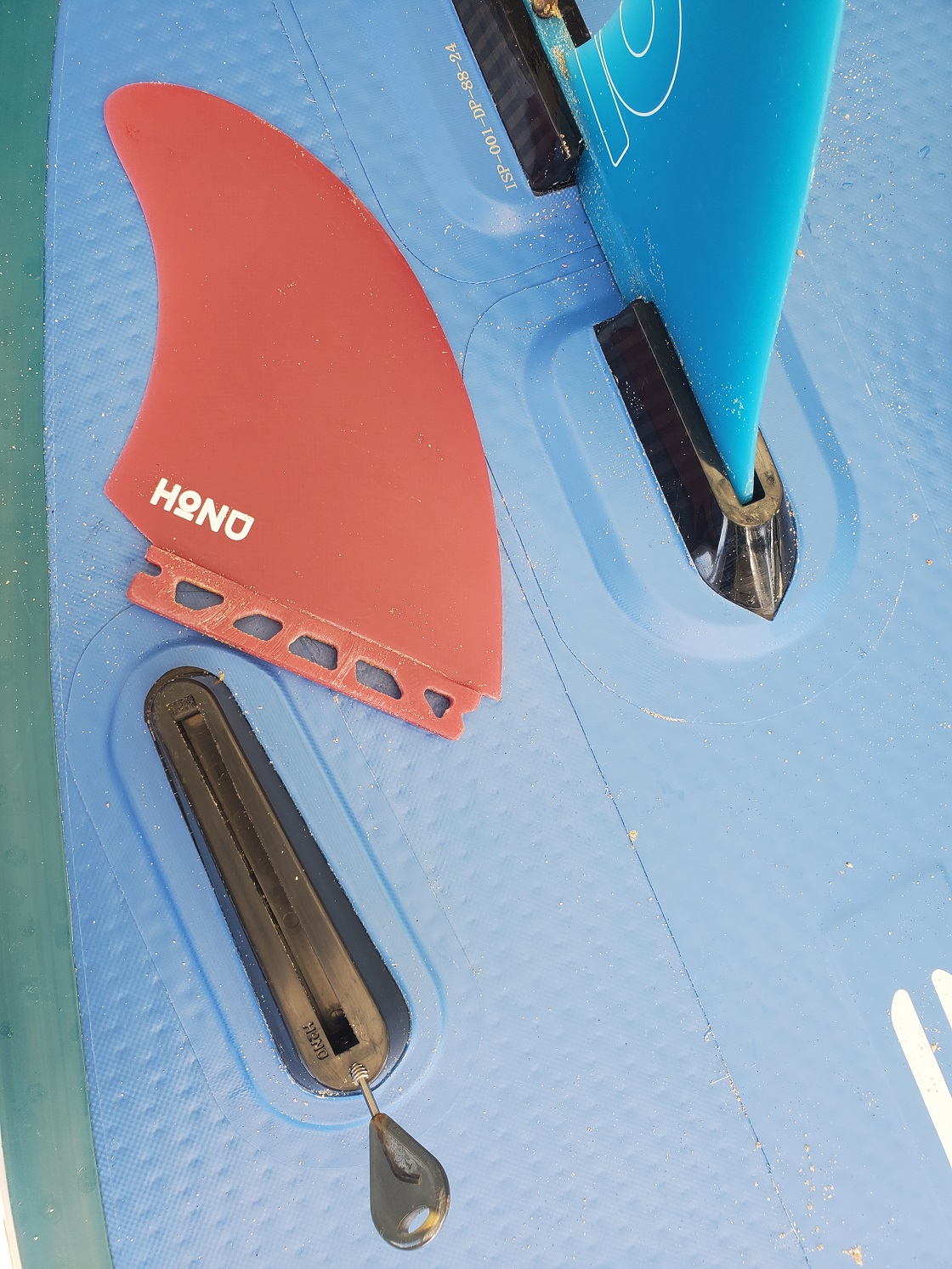
The fins themselves are constructed from volan fiberglass and are extremely high quality. The side fins are asymmetric (only foiled on the outside). Volan is tough and stiff, and a good choice for this type of board. However, the great thing about the fin system that Honu have used on the Bondi is that there is a vast array of fin sizes, materials and shapes available to fit into the US boxes and Futures boxes they have used. So you can experiment all you like to find out what works best for you.
Included Accessories:
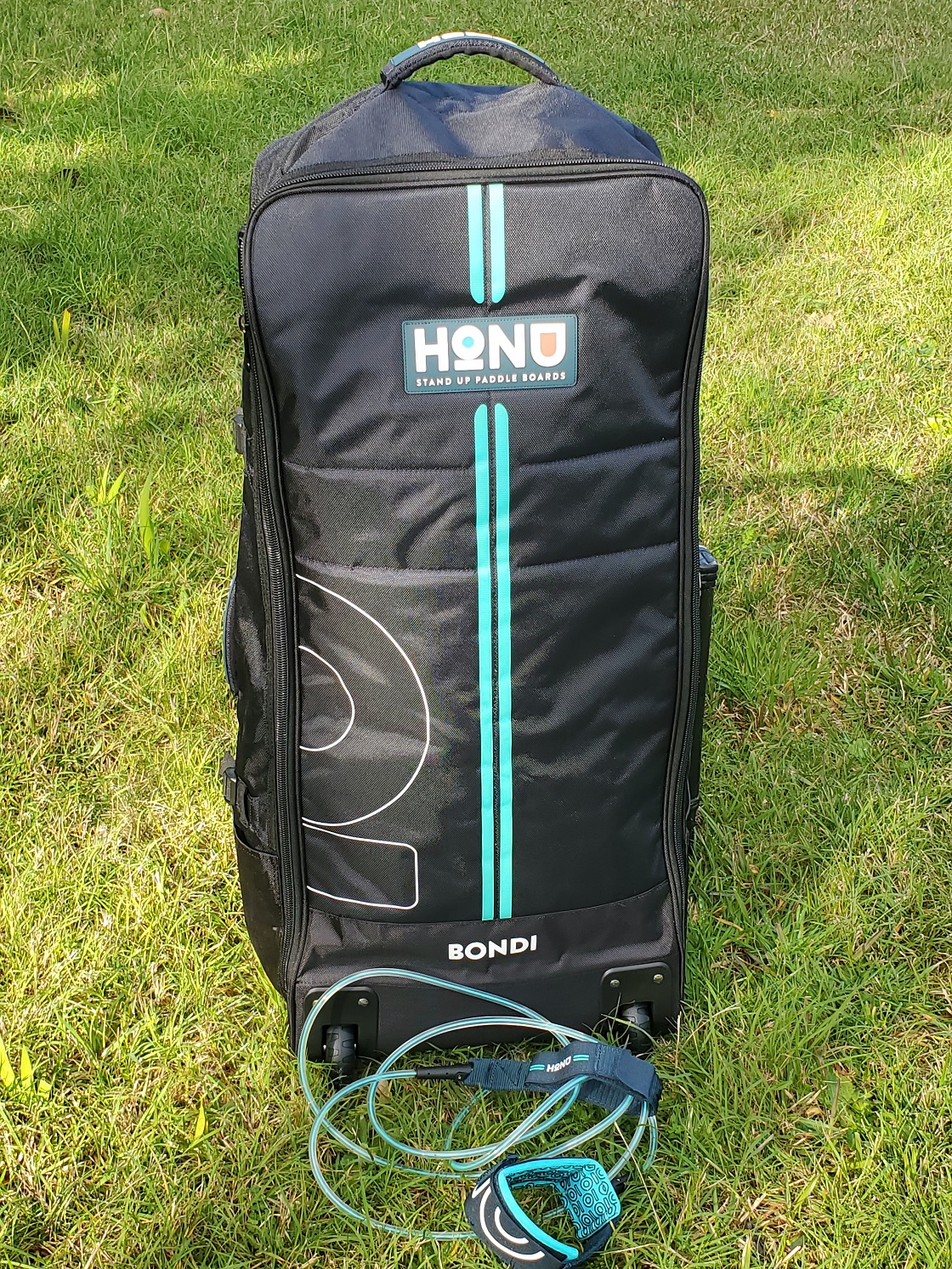
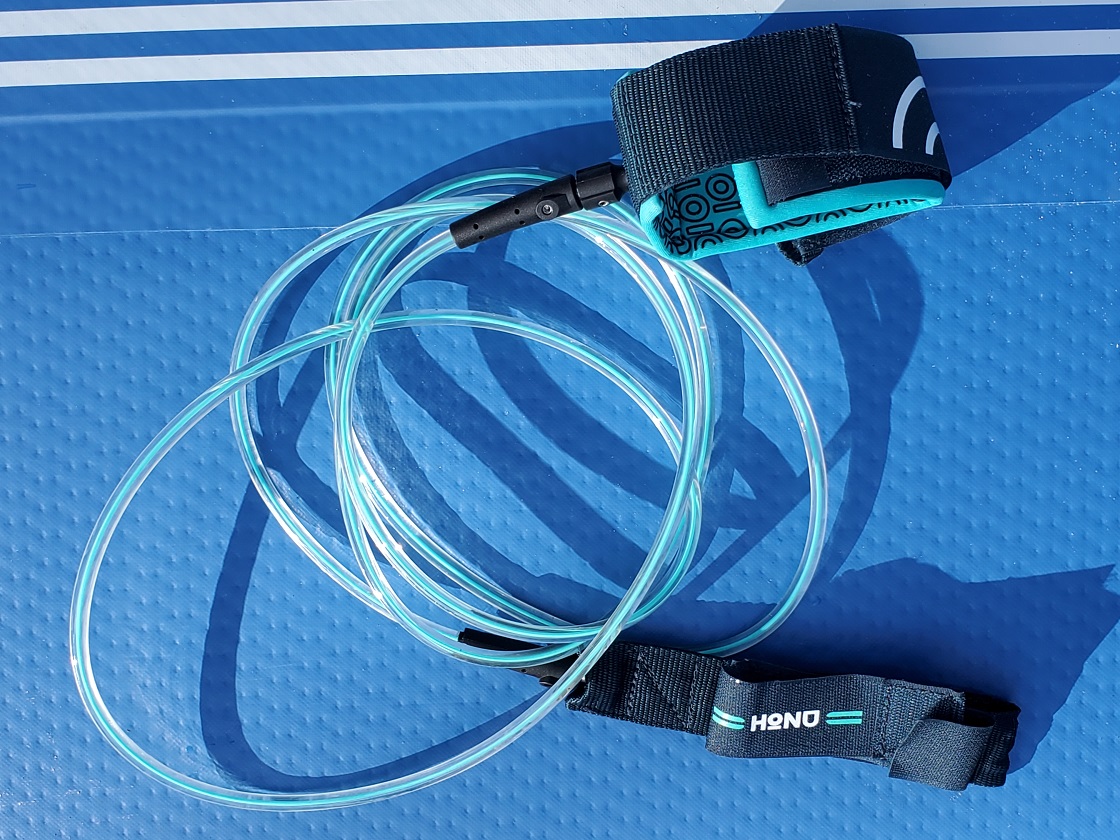
The only other accessories that the board comes with are a 9’ surf leash (which is fine), and the carrying bag, which has rucksack straps and wheels and it too is absolutely fine. No paddle or pump; if you’re experienced enough to be thinking about SUP surfing then you’ve probably got these already. If you haven’t, then we’d thoroughly recommend Honu’s Evo Bamboo/Carbon 3 piece paddles, and Honu’s hand pump is light, efficient, folds down pretty small and has a deflate option to make it easier to get all the air out of the board after use.
Summary Review of the Honu Bondi 8’8″ & 9’5”
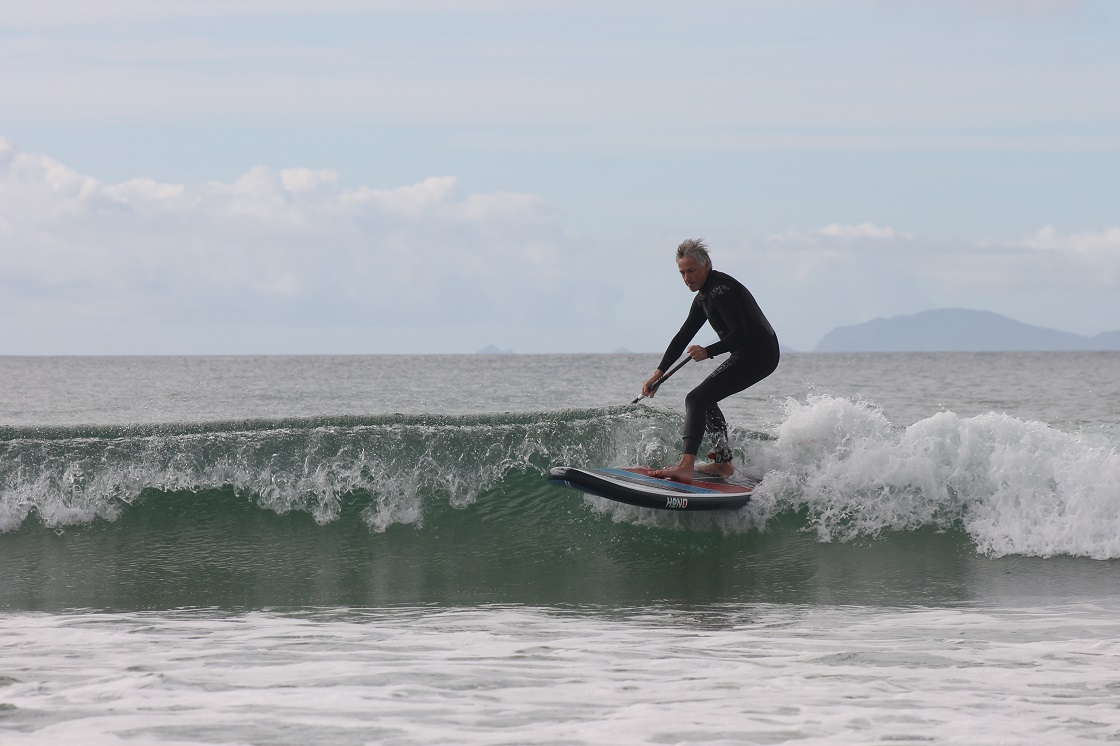
So as you can tell from our review, we’re very big fans of what Honu has achieved with the Bondi 8’8” and 9’5”. Let’s now go back to those three main types of buyer who would be interested in a board like this.
If you’re currently already surfing on an inflatable sup, having fun but painfully aware that it’s not ‘the real thing’, then you’re going to love the Bondi 8’8”. You genuinely can sup surf on this and have a great time. No it’s not exactly like a hard board, but it’s not a million miles off.
If you’re new to sup surfing in general, and are wondering whether this would be a good tool for getting into it, then the answer again is yes. The Bondis are stable, forgiving and ideal for learning to surf on. Plus which, an iSUP is going to hurt a whole lot less than a hard board if it hits you, which is actually a huge consideration, especially if you’re not in the first flush of youth!
For this role, we’d suggest that the Honu Bondi 9’5 will be a better bet for the first time sup surfer, particularly for anyone much over 160 lbs. This is simply because beginner surfers will find it easier on the longer board to paddle onto the wave. Being so short and wide, the Bondi 8’8” needs to be paddled aggressively if you want to catch that wave, and ideally, you should learn how to put some draw into your paddle stroke so that you can paddle on one side without needing to change over. You can’t just glide onto the wave like you can on a longer, naturally faster board.
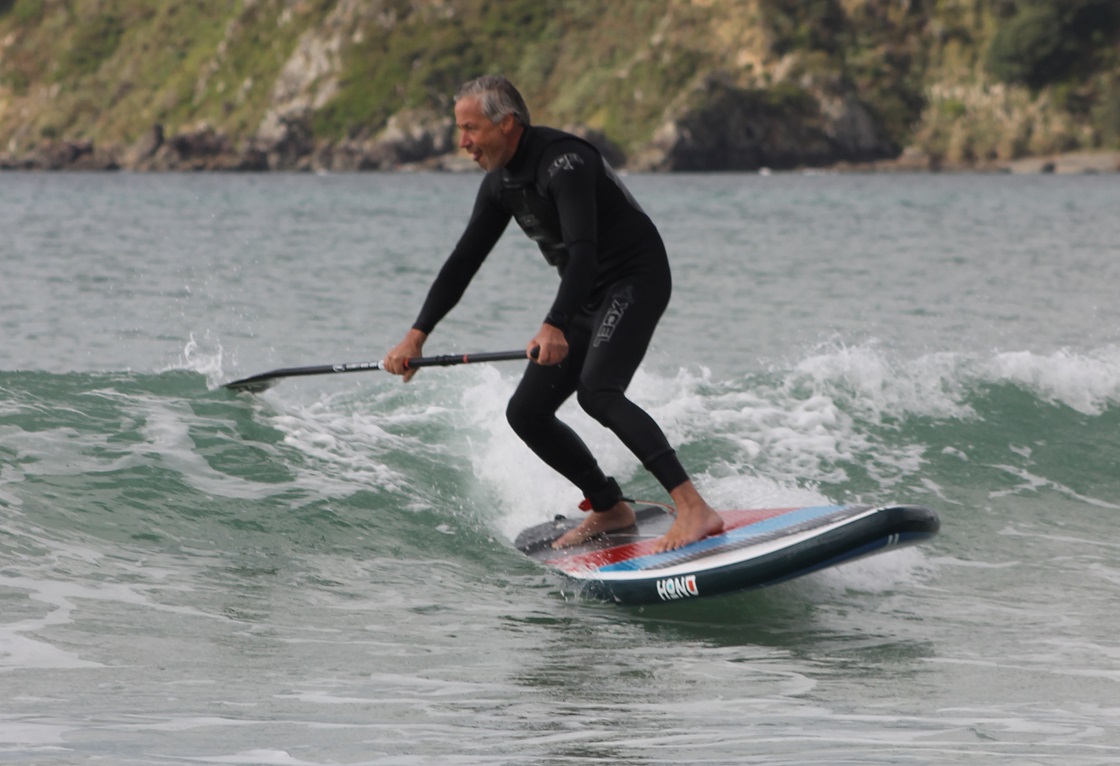
As for the final category of potential buyer; the existing SUP surfer who likes the idea of a traveling SUP surf board. Let’s explore this scenario a bit more. A board for this role needs to be a ‘jack of all trades’ design, capable of performing in whatever conditions you find on your travels. Which may range anywhere from slow crumbly wind swell waves, to some faster more punchy surf. Onshore winds, offshore winds, big, small, fast, slow – your traveling board is the only ride you’ve got so you’re going out there.
We’ll focus our comments here on the Honu Bondi 8’8”. Does it deliver in this role? Absolutely. Will we use it in this role? Absolutely. Is there any other iSUP that we’d prefer to have in this role? Absolutely not.
Our initial expectation was that the board might be limited to more full-on conditions only, because being so short, wide and rounded (and made of PVC) it would be too slow to function in anything other than clean steep surf. However, we were very pleasantly surprised by how easy it was to paddle in on slower, less well formed swell. We also really like the fact that you can adjust the fin configuration and make it into some quite different performance profiles.
You may well be thinking, OK, but 8’8” is still pretty damn short – is it too short to be an all-rounder? The thing is, the board has such good stability and is so user-friendly that it actually feels like a much bigger board. Think of it as more like a 9’0, even a 9’3. Don’t let the short length put you off. Any paddler who has ridden some waves should be able to enjoy this board with no problem at all.
You will notice a couple of differences to your regular hard surfboard, beyond the ones already discussed in this review. The first one you’ll pick up on straight away as you paddle out. Having that wide thick and high volume nose means that the board goes over the white water in a slightly different fashion. There’s more of a bump; it doesn’t pierce it like a hard board does, it wants to float up and over it. A bit of weight on the back foot at the critical moment to assist the nose in coming up helps a lot. The board doesn’t fare quite so well when you’re trying to punch through a bigger wall of freshly-broken white water, it’s more prone to being picked up and pushed back. You’ll soon learn what you can and cannot get away with.
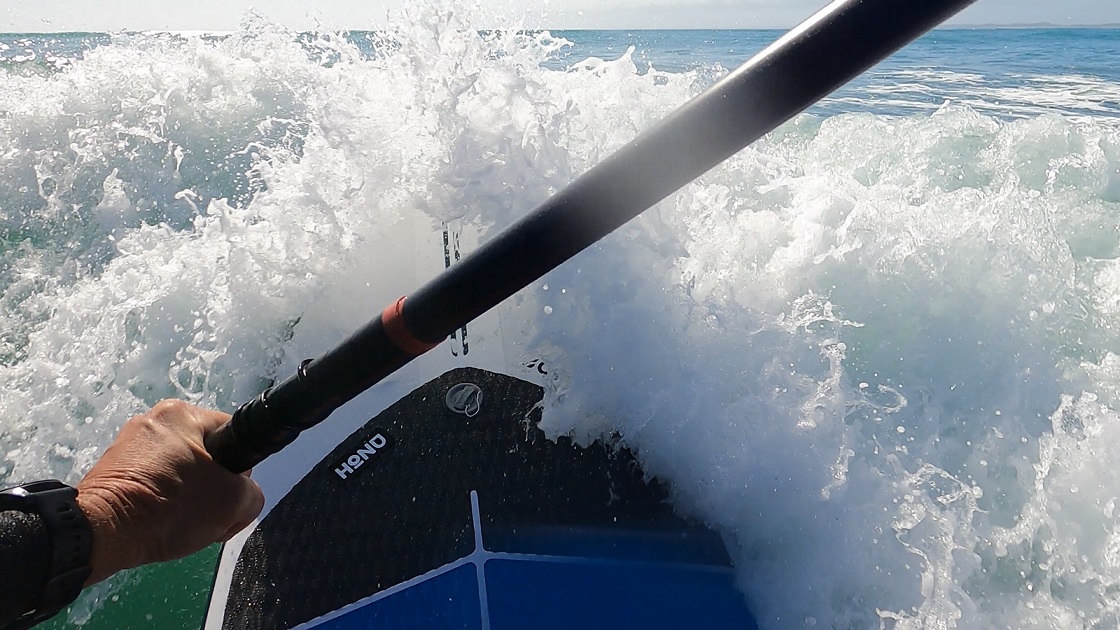
The other time you really notice that you’re on an inflatable rather than a hard board is at the end of the wave ride, when the wave has broken and you want to get off the white water. Whereas on a hard board you can simply put the brakes on by sinking the tail a bit, letting the wave wash through, and then pivoting around to paddle back out again, the much higher volume of the Honu Bondi tail means that you need to commit a whole lot more weight to the tail to actually get it to sink. Indeed, if you’re on a big foam ball you might just not be able to get off it at all, and will have to wait until the wave has dissipated further before you can sink the tail and get off it.
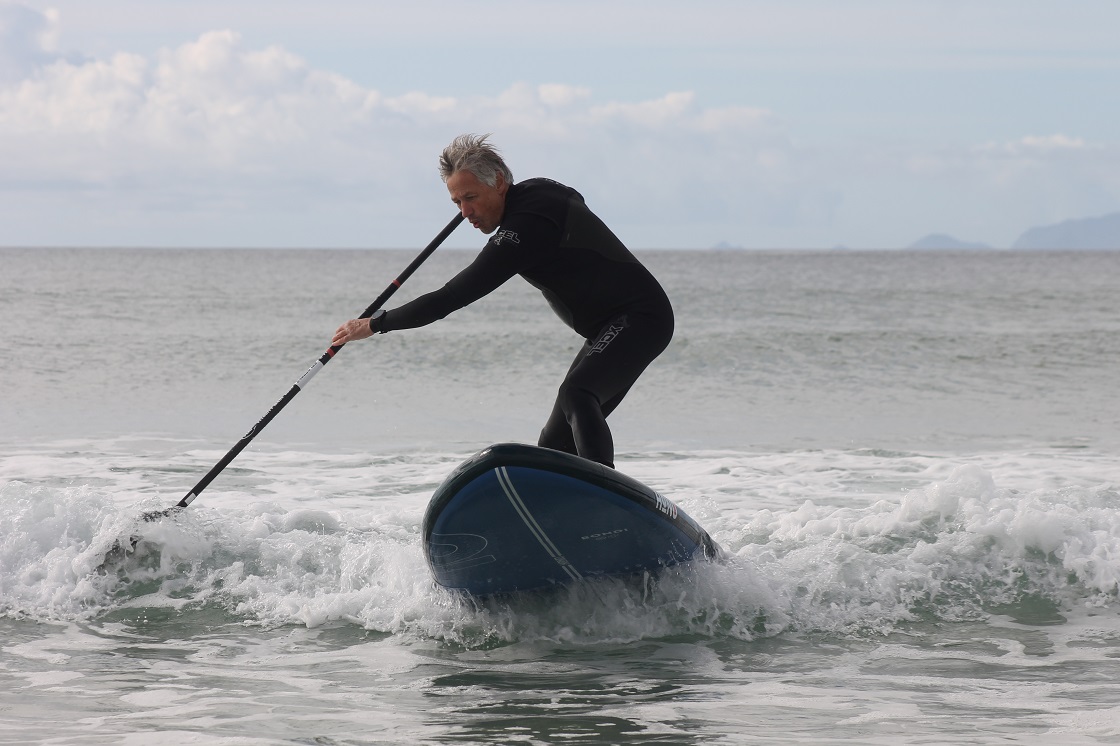
But these are minor points and essentially just differences rather than pros or cons. The one area where the all-round traveling surf sup scenario will probably not work is if you’re looking to get deep on a super fast hollow reef break. We haven’t had the chance to put this properly to the test, but we suspect that this might just be a challenge too far. Our guess is that speed (or lack of) will be the issue, and the thick rails simply aren’t going to be capable of holding in on a bowling wave. But we will be delighted to be proved wrong on this – if you get the shots of you deep in an Indo barrel on your Honu Bondi we promise we will print them!
So has Honu nailed it 100%, or could it be made even better? We have two very minor suggestions – and to be clear, these should not in any way be taken to mean that the current model has a problem in these areas.
Firstly, we’d be interested to see how it works with the stomp pad just an inch or two further back. It feels like there is the potential to gain even more crank in this regard.
Secondly, we feel that there is potential to tweak the nose outline just slightly, to reduce the drag and find a bit more natural speed out of the design, without compromising the stability. We’re currently discussing this with Honu and look forward to seeing what develops.
OK, We hope you enjoyed this review of the Honu Bondi 8’8″ and 9’6. Definitely one of our longest write-ups to date, but there was a lot to say and we hope you’ve found it useful and informative.
Happy paddling! If you have any questions or comments please leave us a comment below!
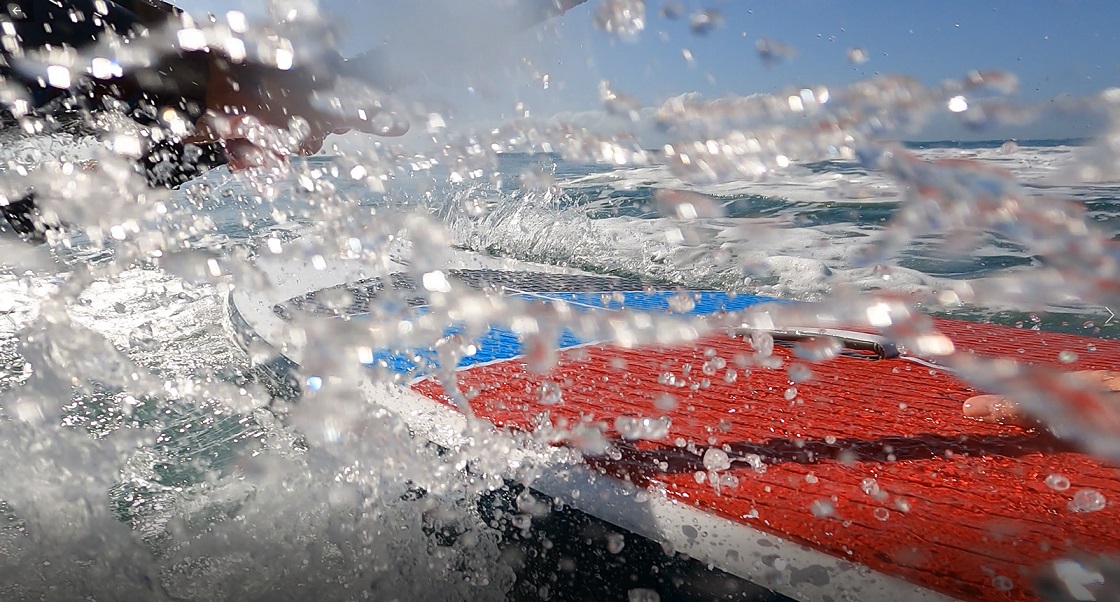
SupBoardGuide
Latest posts by SupBoardGuide (see all)
- Best Paddle Boards for Beginners, 2025 - July 3, 2025
- Hala Radito Whitewater iSUP Review – 2025 - June 27, 2025
- Hala Atcha 96 Whitewater iSUP Review – 2025 - June 16, 2025


